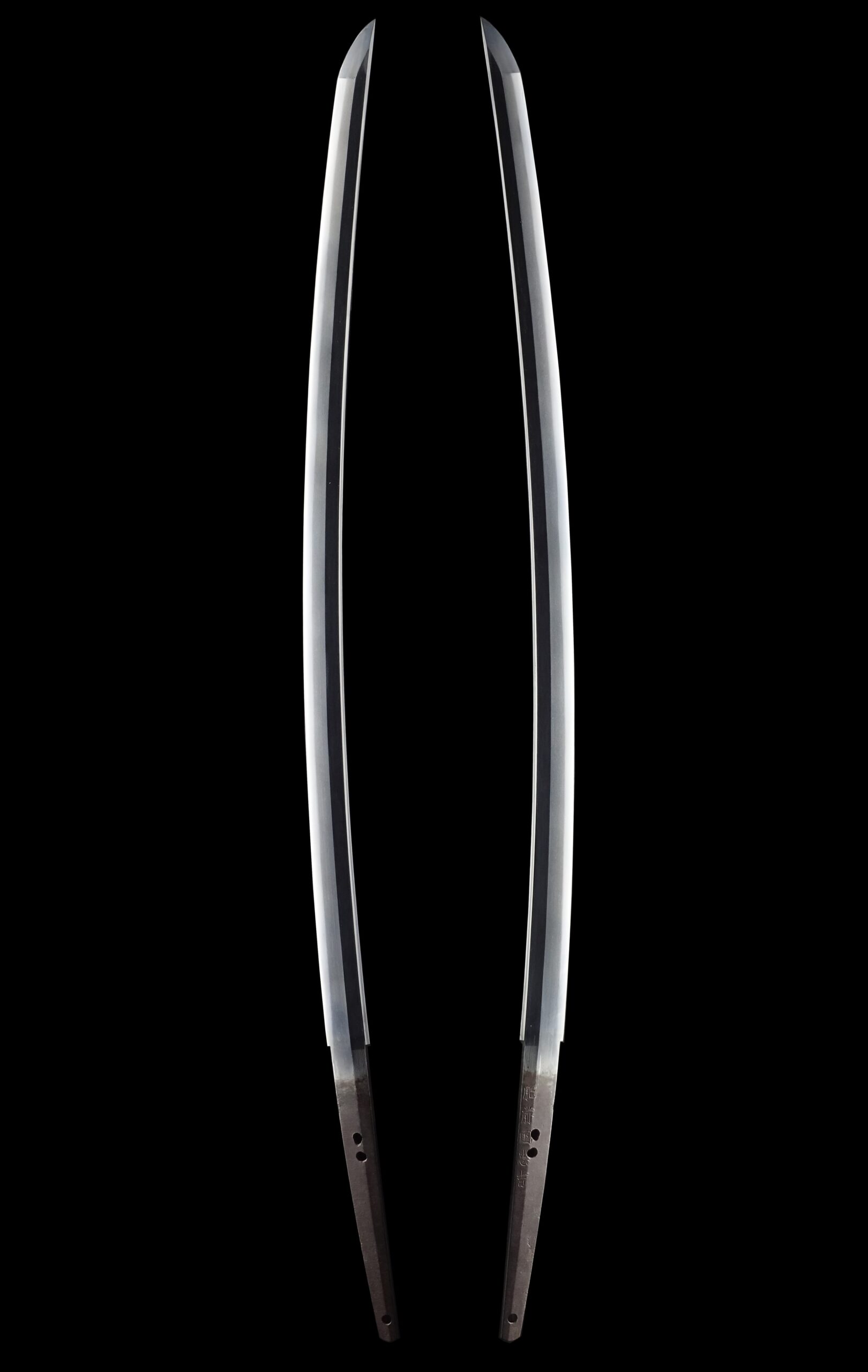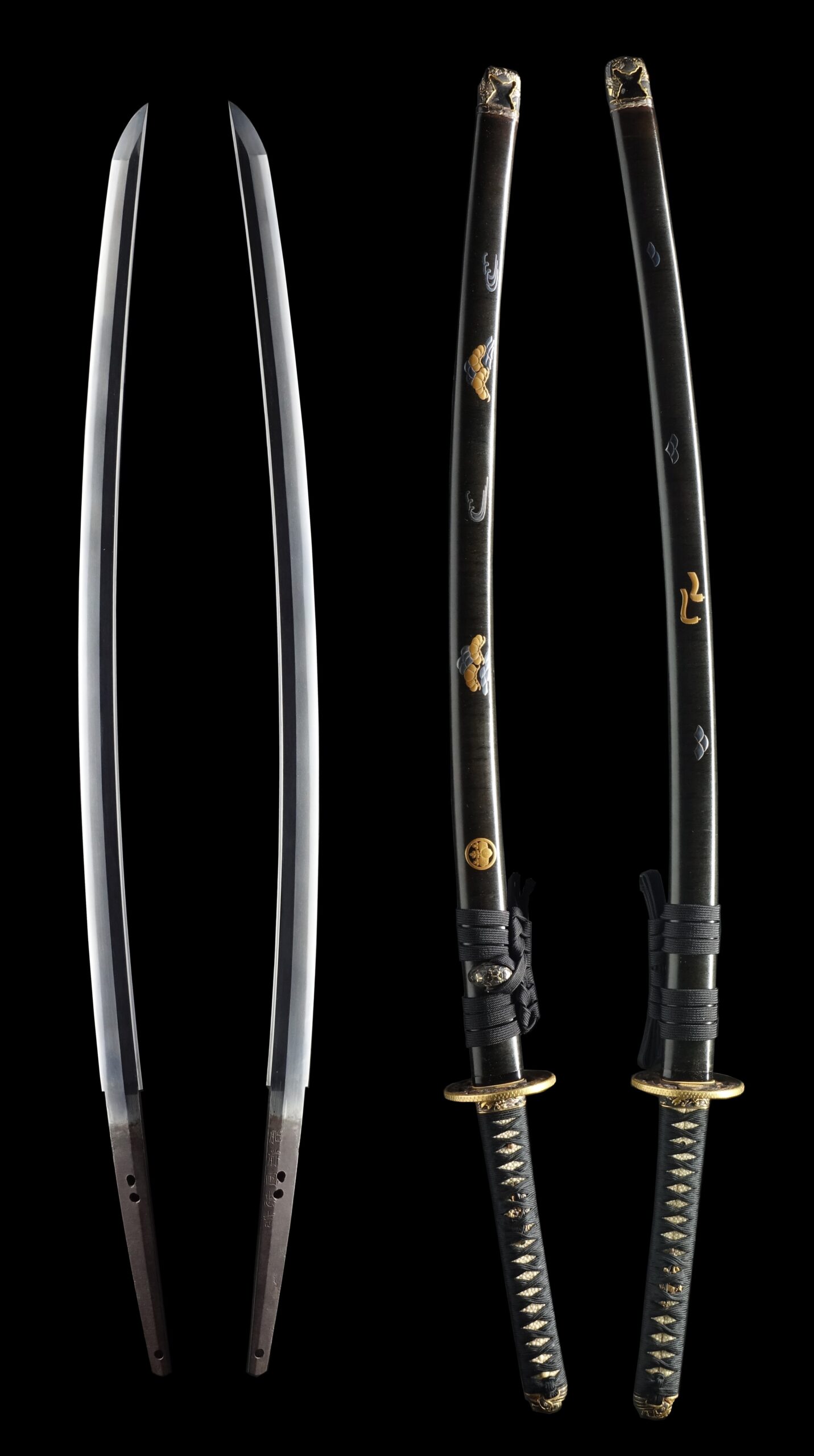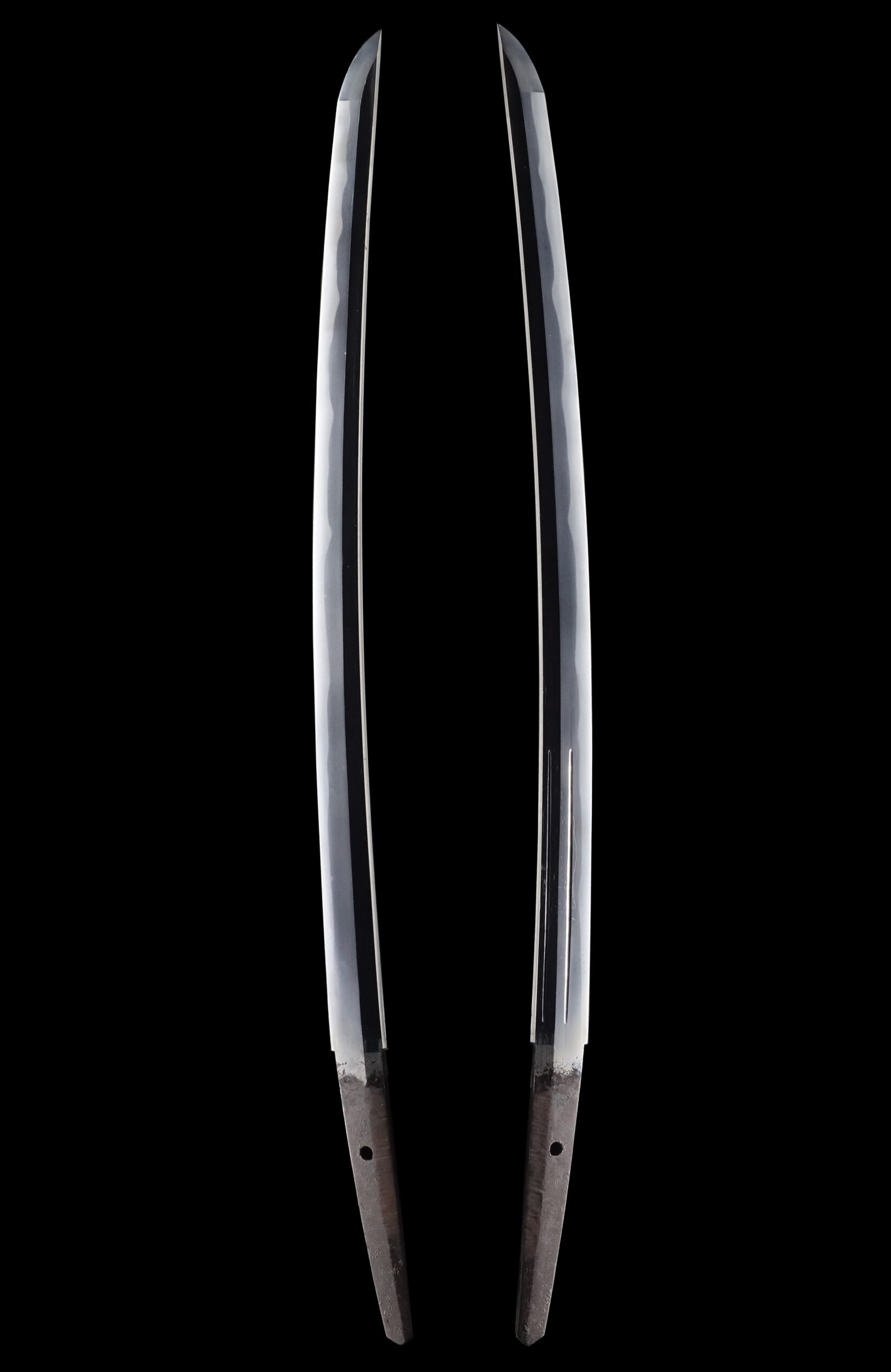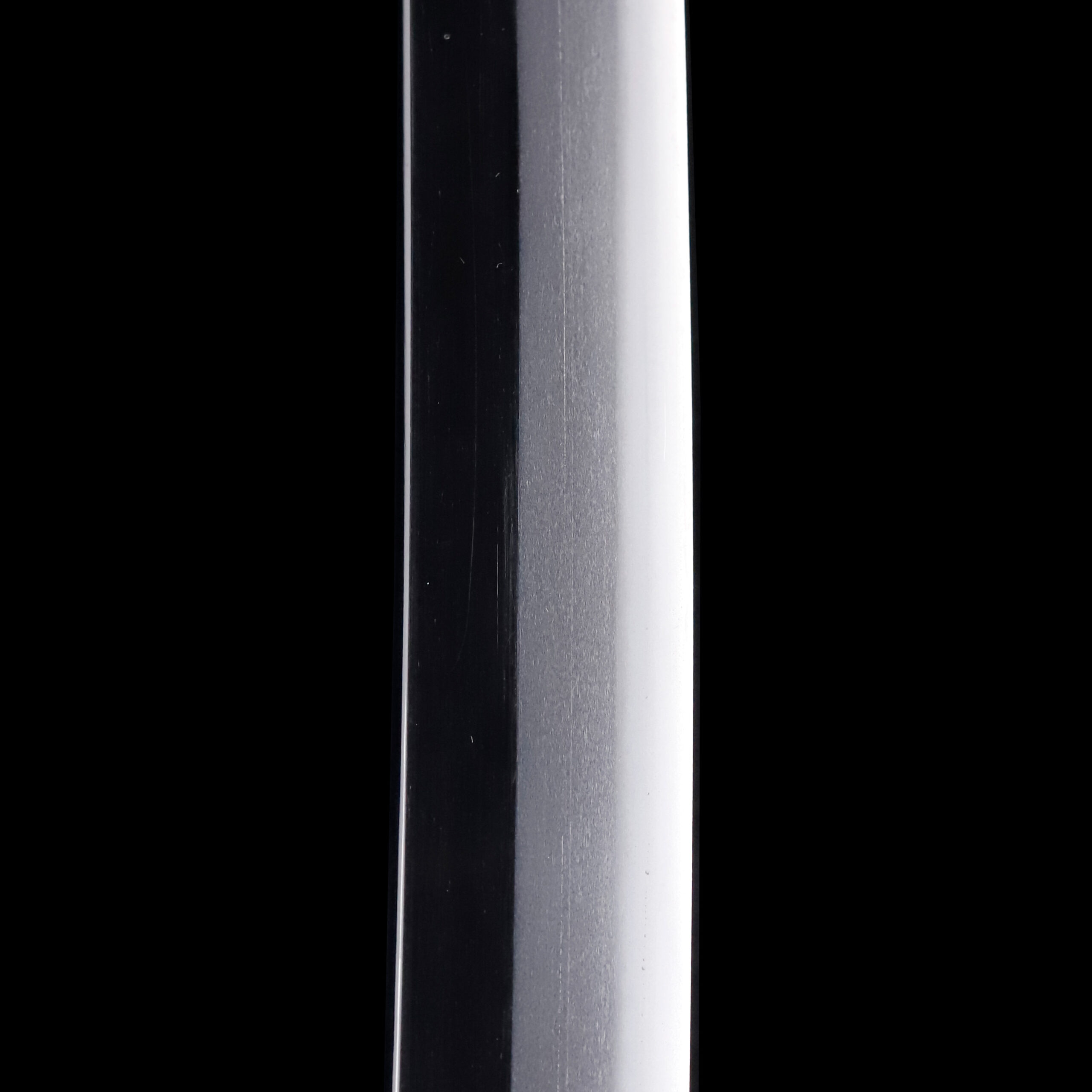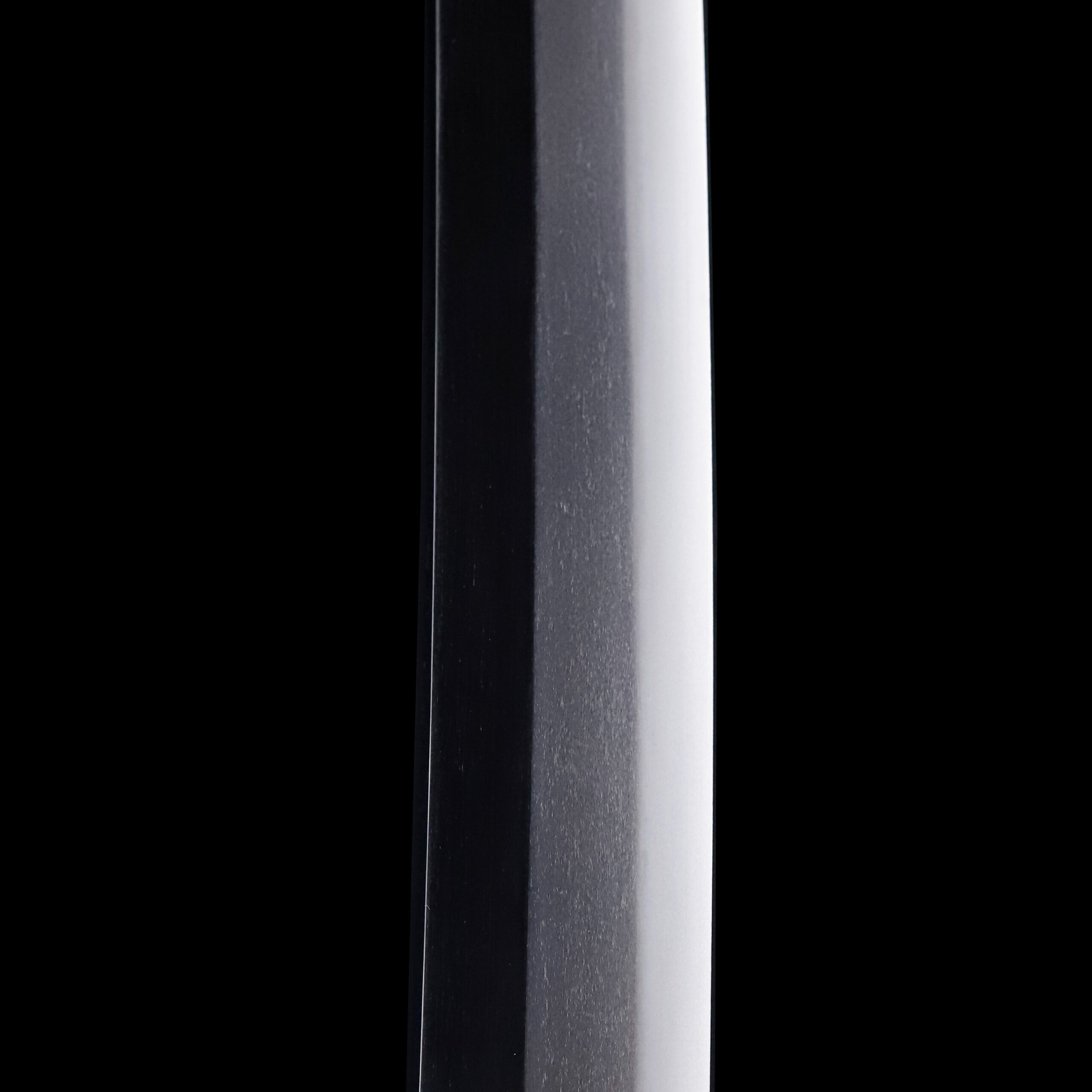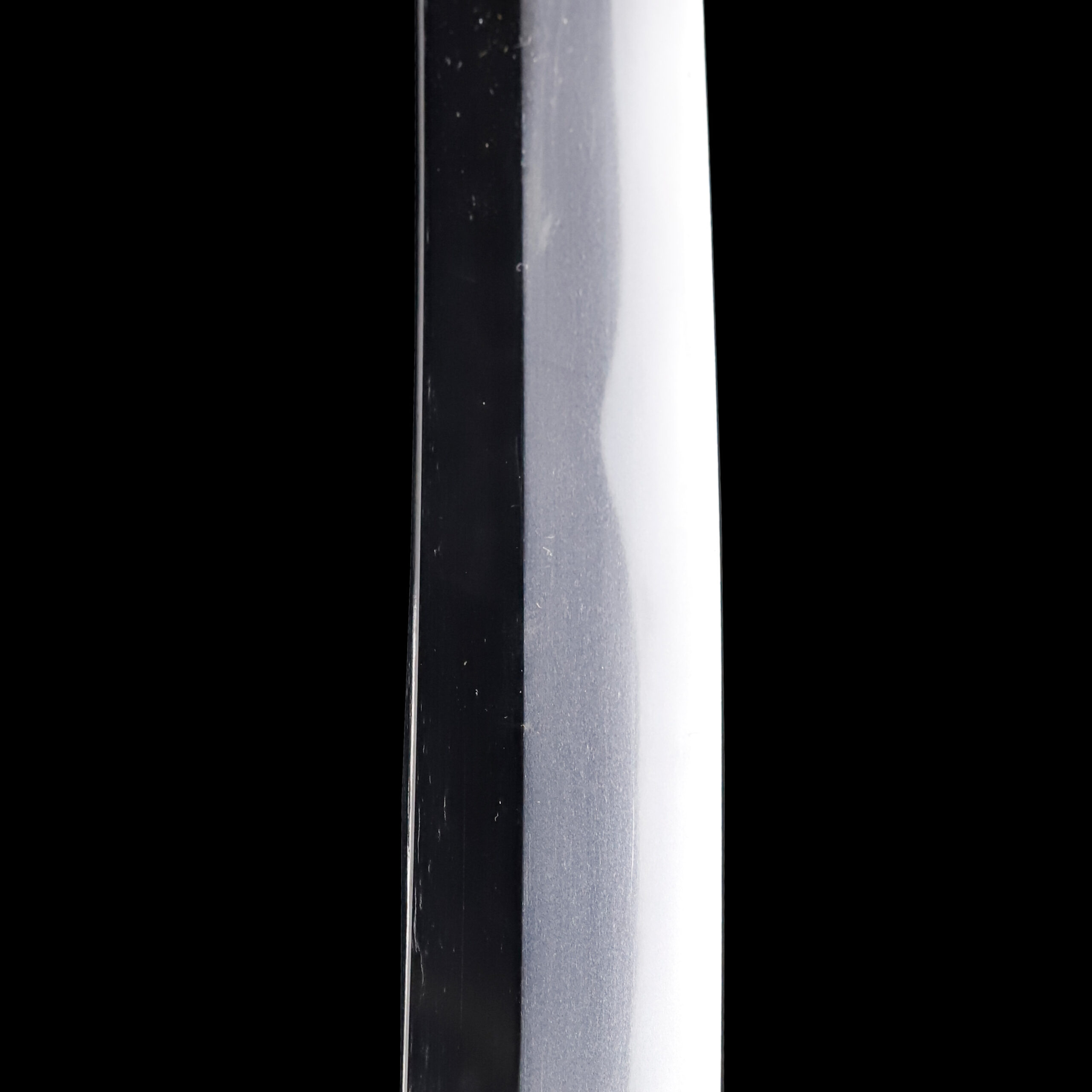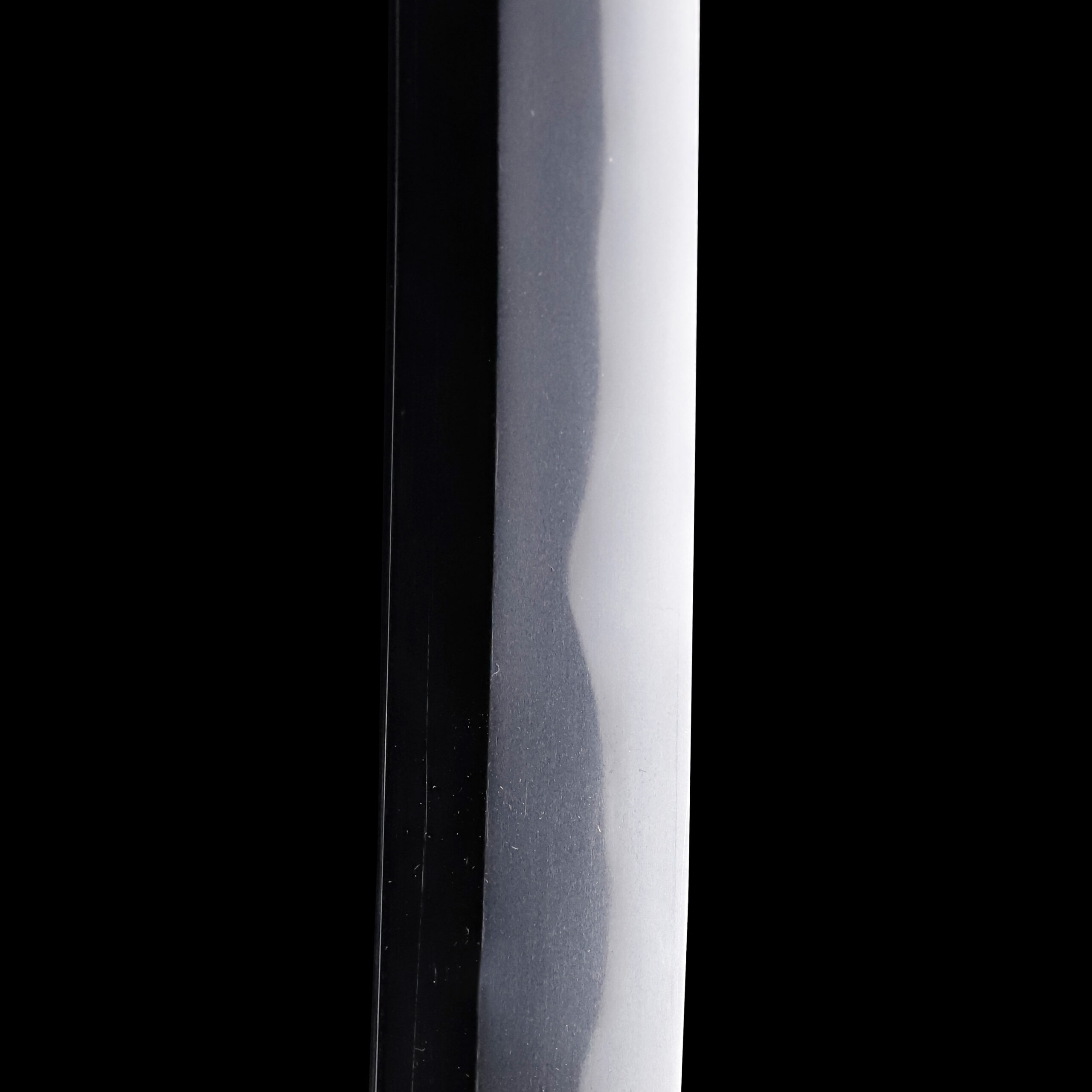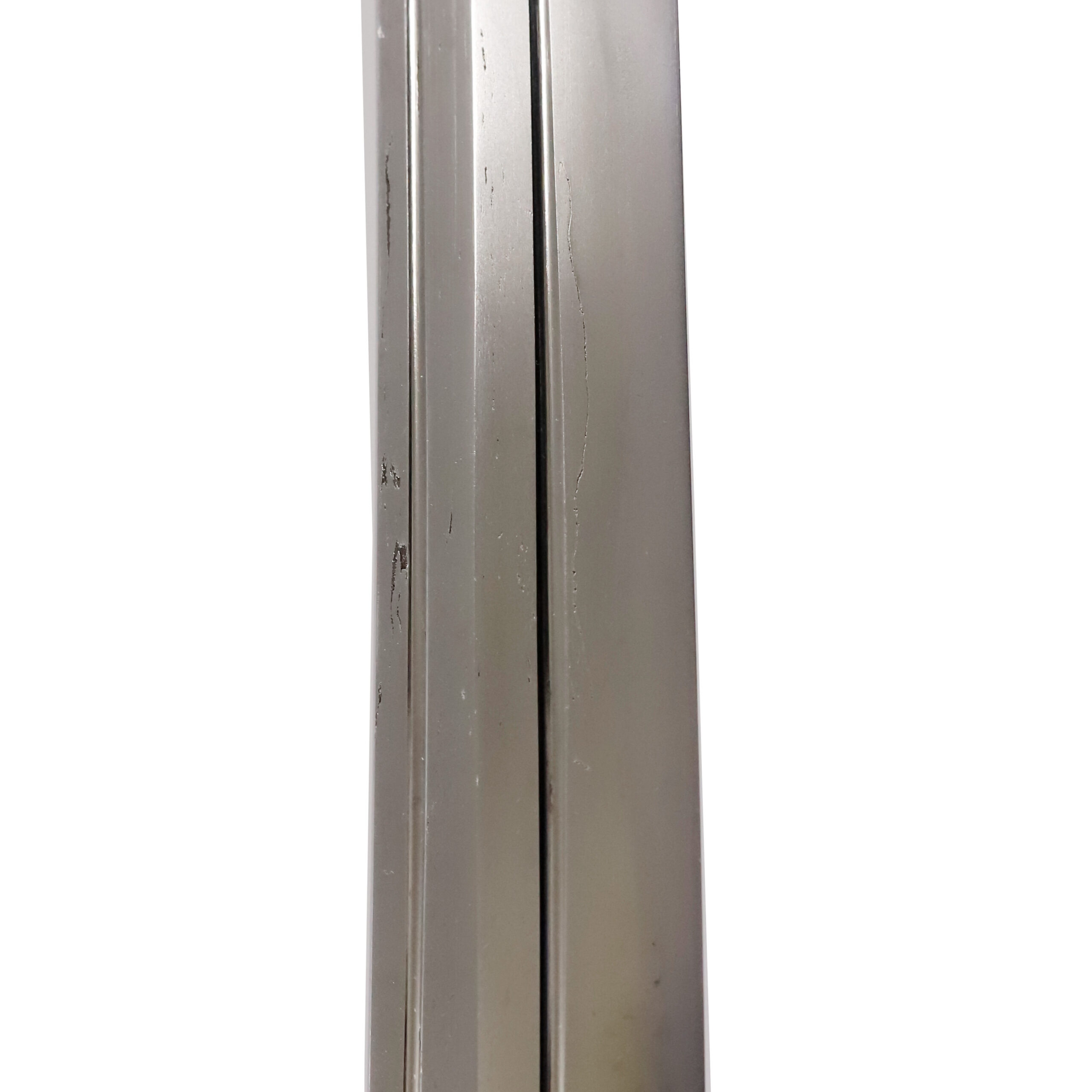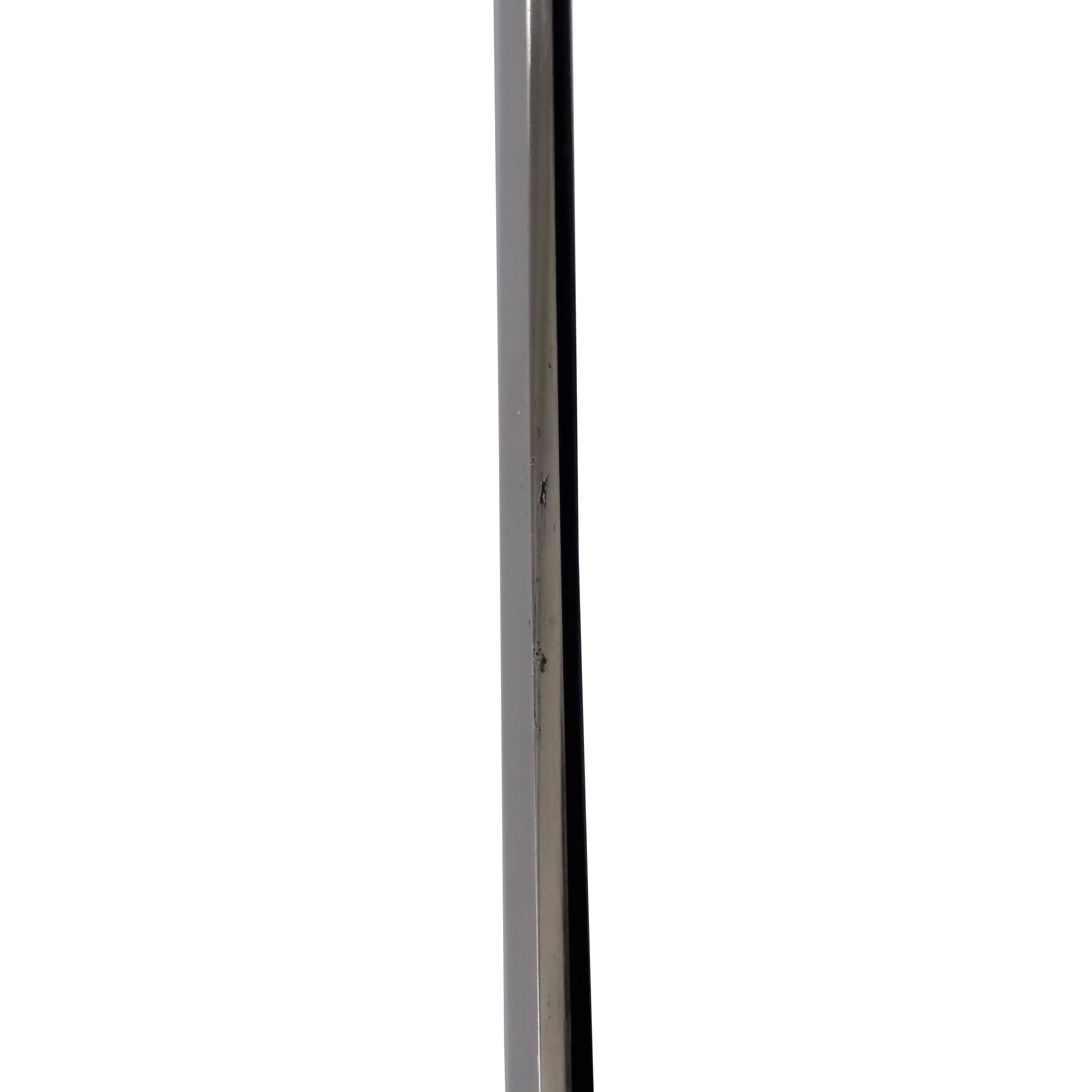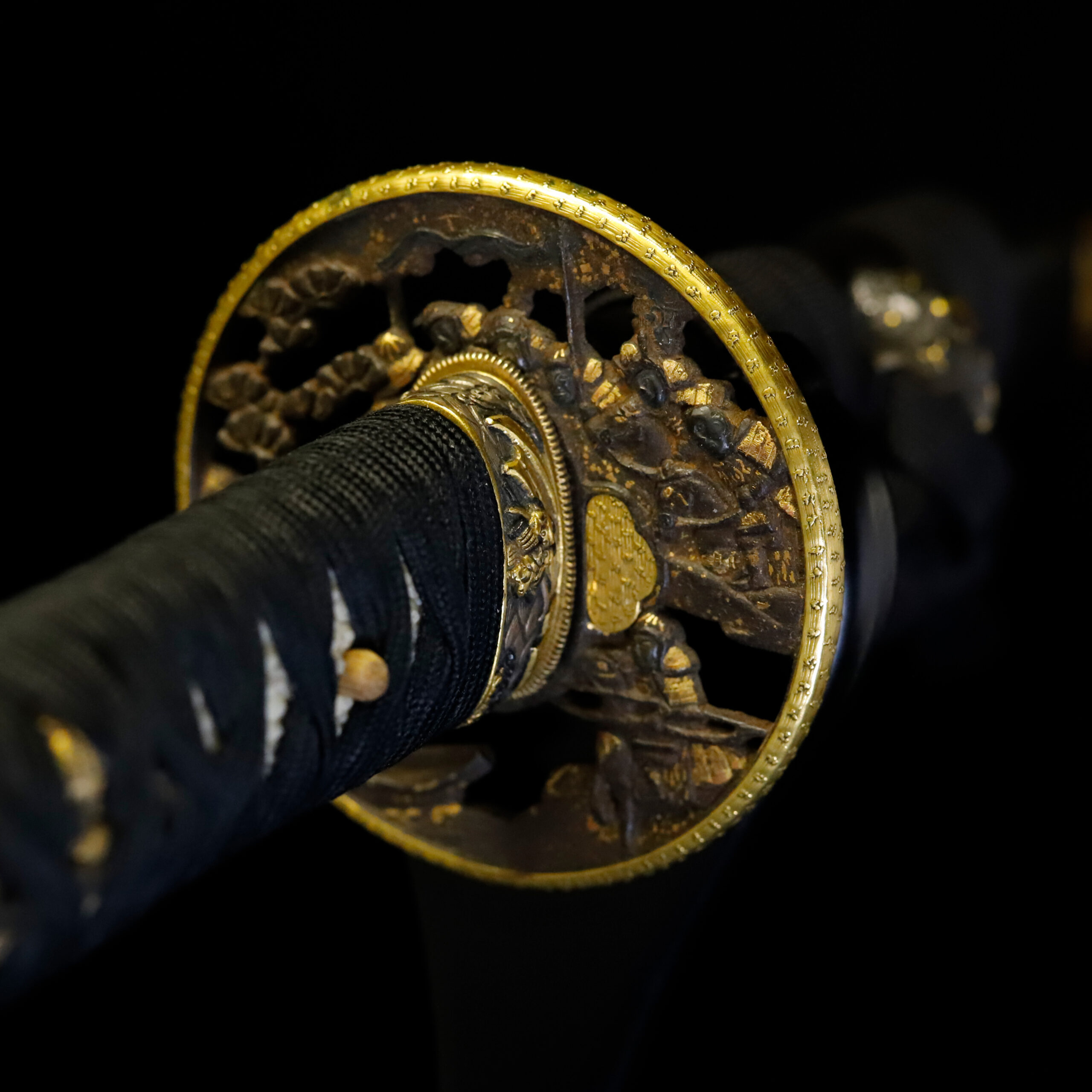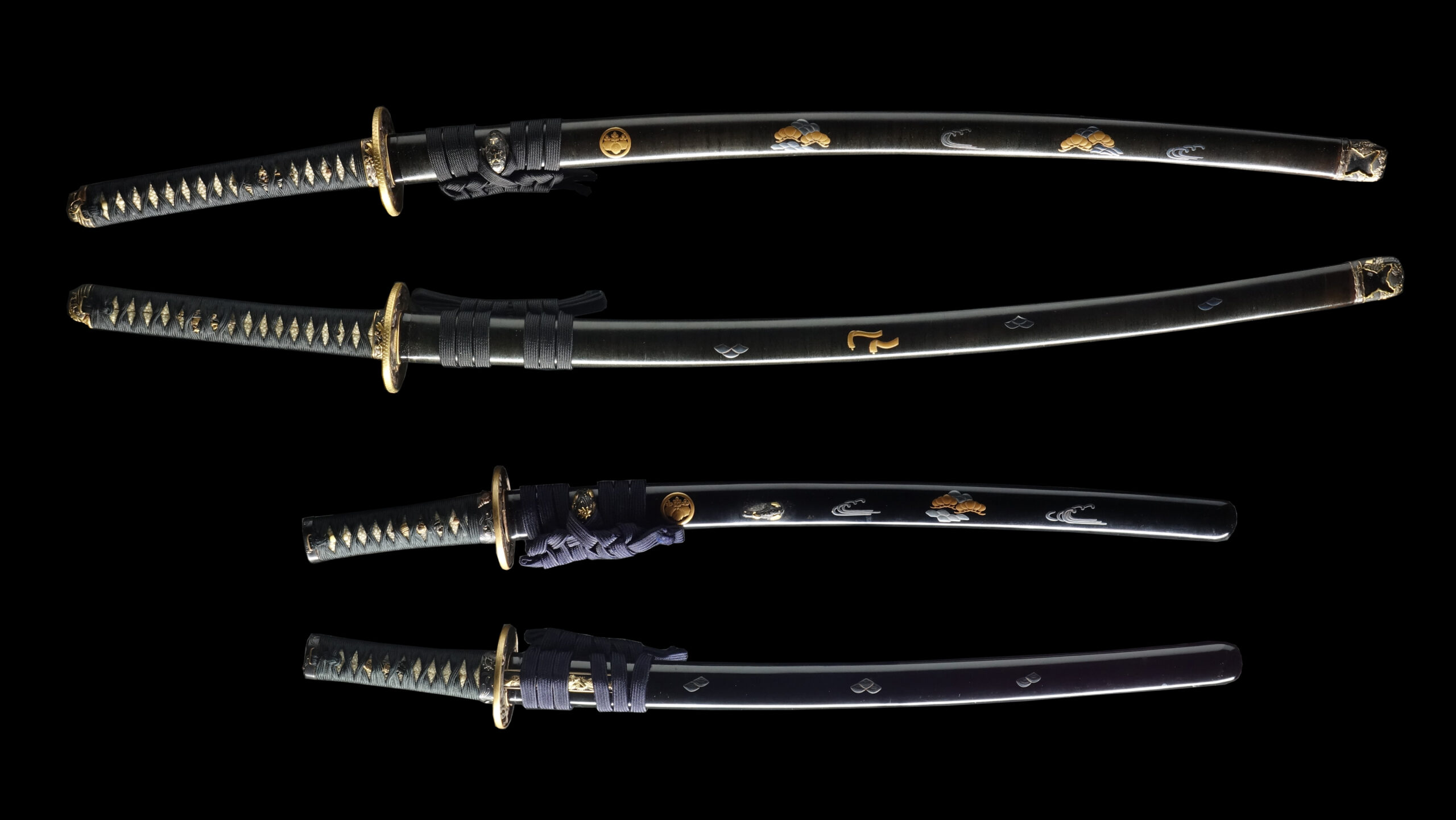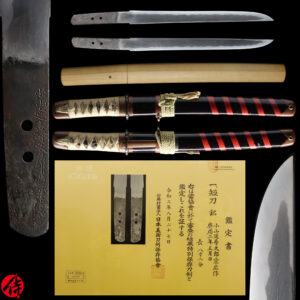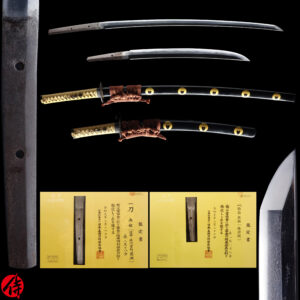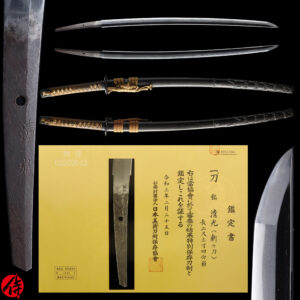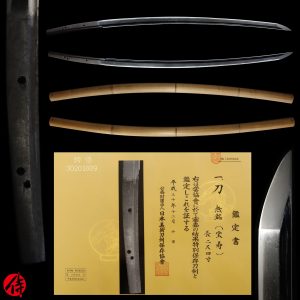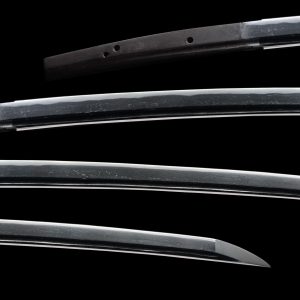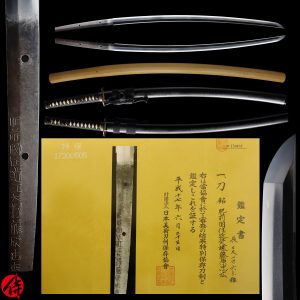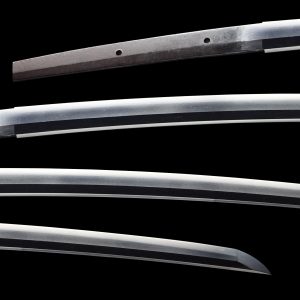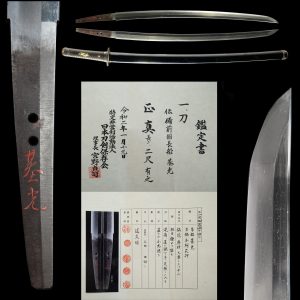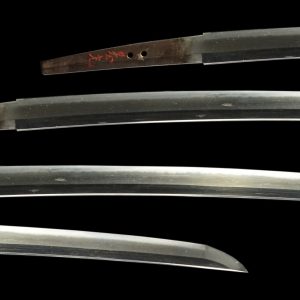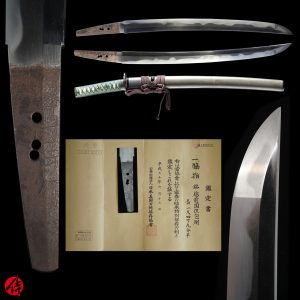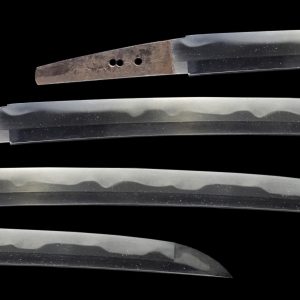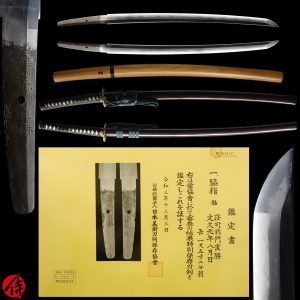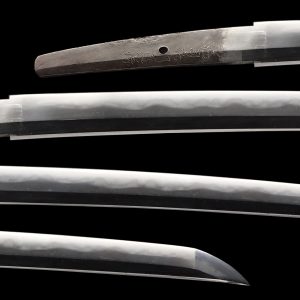Antique Japanese Sword Daisho attributed to the 8th gen Tadayoshi & attributed to Takada Teruyuki with NTHK Kanteisho Certificate
【Description】
■Katana attributed to 8th gen Tadayoshi
This blade was signed by Hizen Koku Tadayoshi (肥前国忠吉). The maker’s name Tadayoshi lasted nine generations during the Edo period. According to its NTHK’s appraisal, it was made by the 8th- gen Tadaysohi (八代忠吉) during the Ansei era (1855-1860). Among other generations of Tadayoshi, the eighth-gen was a renowned figure and mastered a high level of craftsmanship passed down from the previous generations. All the generations of Tadayoshi served Nabeshima clan, which controlled Saga domain (Today’s Saga prefecture).
The 8th-gen Tadayoshi was born as the son of Furukawa family in Saga domain in 1801. He was eventually adopted by the 7th-gen Tadayoshi, and he changed his name to Hashimoto Shinzaemon (橋本新左衛門). He took over Tadayoshi school from the 7th-gen in the 13th year of the Bunka era (1816).
The domain acknowledged his skill, and he played a vital role in modernizing the weaponry of Saga domain. In 1850, he was in charge of making a cannon for the domain because of his refined blacksmithing. He died at 59 in the 6th year of the Ansei era (1859).
The first gen Tadayoshi school
The first-gen Tadayoshi was born and raised in the Saga domain. In 1596, under the domain’s order, he went to Kyoto to learn the sword-forging technique from Umetada Myojyu(埋忠明寿), one of the greatest swordsmiths in the early Edo period. He improved his craftsmanship and returned to the Saga domain two years later (1598). The first head of the Nabeshima clan, Nabeshima Katsushige, appreciated the work of the first-gen Tadayoshi very much. Then, Katsushige appointed him as his Okakaekaji, a swordsmith who exclusively forged swords for a specific domain or clan. And Tadayoshi started to stay near Saga castle, which is the headquarter of the Nabeshima clan. And, he founded Hizen Tadayoshi school, which trained more than 100 swordsmiths during the Edo period. 5th gen Tadayoshi is one of them.
Hizen Domain
The swordsmiths in the Hizen province worked under the auspices of the Nabeshima clan like Tadayoshi. They could produce beautiful blades with Konuka Hada, whose steel surface is very smooth. This Hada is one of the most well-known characteristics of the blades produced in Hizen province. The swordsmiths also used and mixed carbon steel made in western countries. Since Hizenkoku had been flourishing through international trading, it had easy access to western carbon steel.
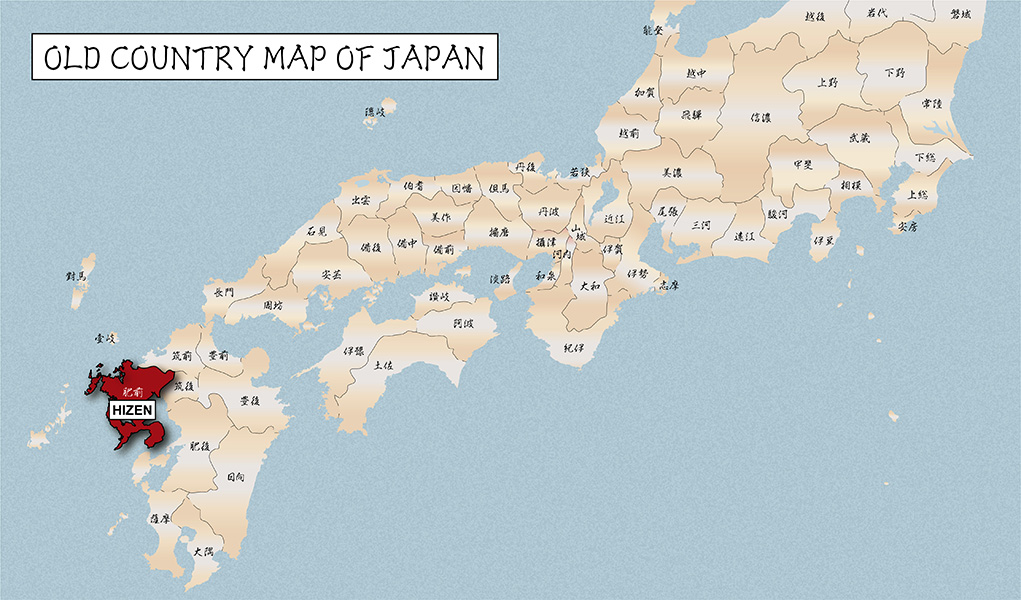
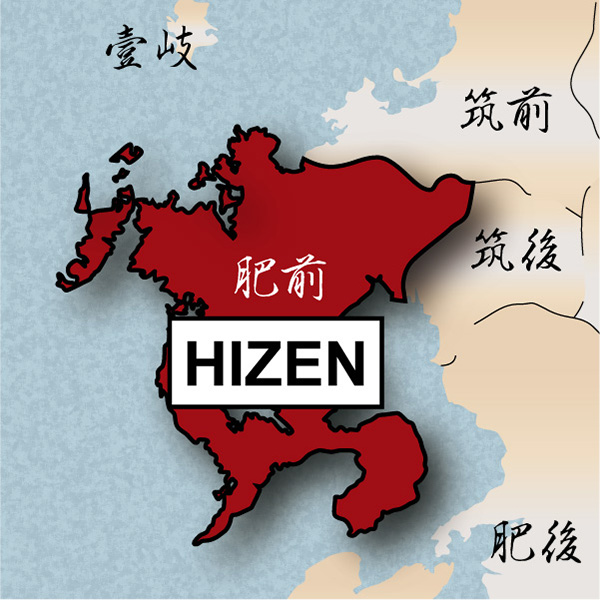
■Wakizashi attributed to Takada Teruyuki
This blade was attributed to Hoshu Takada Teruyuki (豊州高田輝行) during the Enpo era (1673-1681: the mid-Edo period), according to NTHK’s appraisal this December. We are expecting to receive its authentication paper by next January 2023.
Takada school was founded by Takada Tomoyuki in Takada village, Ohita prefecture, during the Nanbokucho period. (1334-1338 A.D). Tomoyuki went to Bizen province(today’s Okayama prefecture) to master the sword-forging techniques of BIZEN and came back to the village and trained his apprentices. That is how Takada school started. Those who forged swords in Takada village before the Edo period are called Taira Takada and Fujiwara Takada during the Edo period. This blade is categorized as a Fujiwara Takada sword.
During Sengoku Period(the warring state period: from late 15 C to late 16 C), the Takada school forged many swords for feudal lords on Kyushu island. It is said that the reputation of the blades forged by Takada school was close to MINO or BIZEN swords, two of which are the most famous sword forging places. This highly skilled sword forging technique was passed down to later generations in the Edo period.
Generally speaking, Kyushu island was prosperous in sword-making because of the long trading history with Asian countries. To gain an advantage in trading, many feudal lords on this island fought against each other. Takada school was able to receive many orders as the demand increased among those lords. The material of Japanese swords(high-quality iron sand and charcoal) was abundant in the mount Sobo Katamuki, located near Takada village. We believe Takada school prospered because of its geographic location and natural resources.
*Please keep in mind that there is one noticeable Kitae Kizu near the straight grove and black rust on the Mune (backbone of the blade).
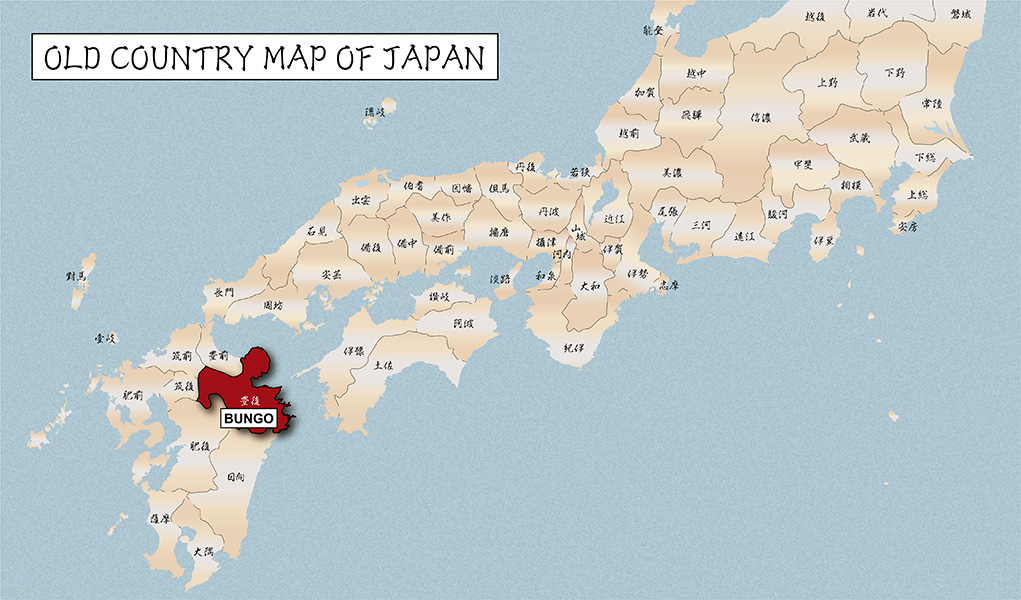
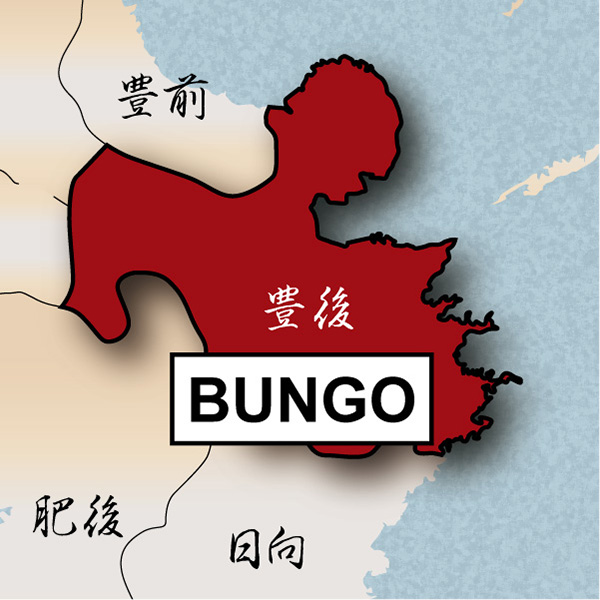
■What is Daisho?
Daisho is a pair of two Japanese swords Samurai carried. During the Edo period, having Daisho in public places was considered social status for Samurai. Furthermore, Samurai were required to wear them under the law back then. Daisho is written as 大=Big and 小=Small. Dai part means Katana, and Sho part means Wakizashi.
【 Blade】
-Katana
Cutting Edge Length(Nagasa):67.2 cm (26.4 inches)
Curvature(Sori): 2.1 cm (0.82 inches)

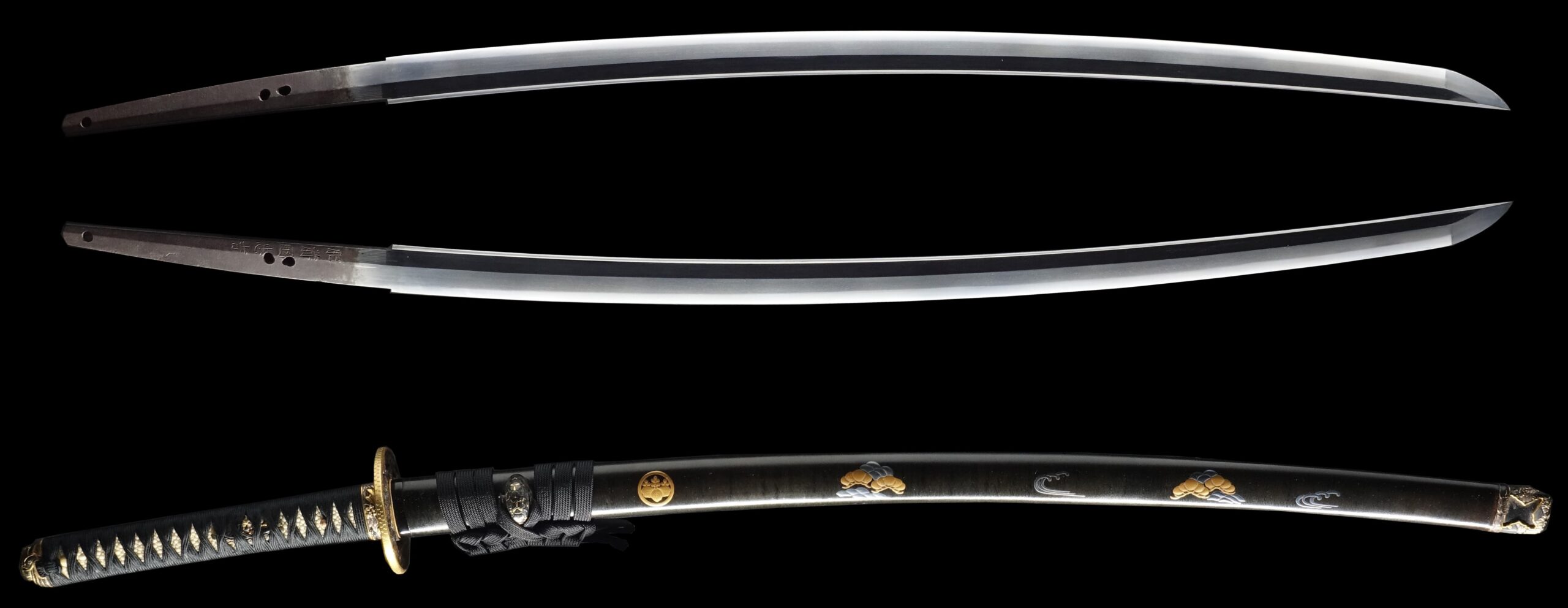
-Wakizashi
Cutting Edge Length(Nagasa):48.7 cm (19.2 inches)
Curvature(Sori):1.1 cm (0.43 inches)


Hamon:
The crystalline structure which forms along the cutting edge of a blade as a result of the hardening process
Jimon(Jihada):
visible steel surface pattern created by folding and hammering during forging process
-Katana
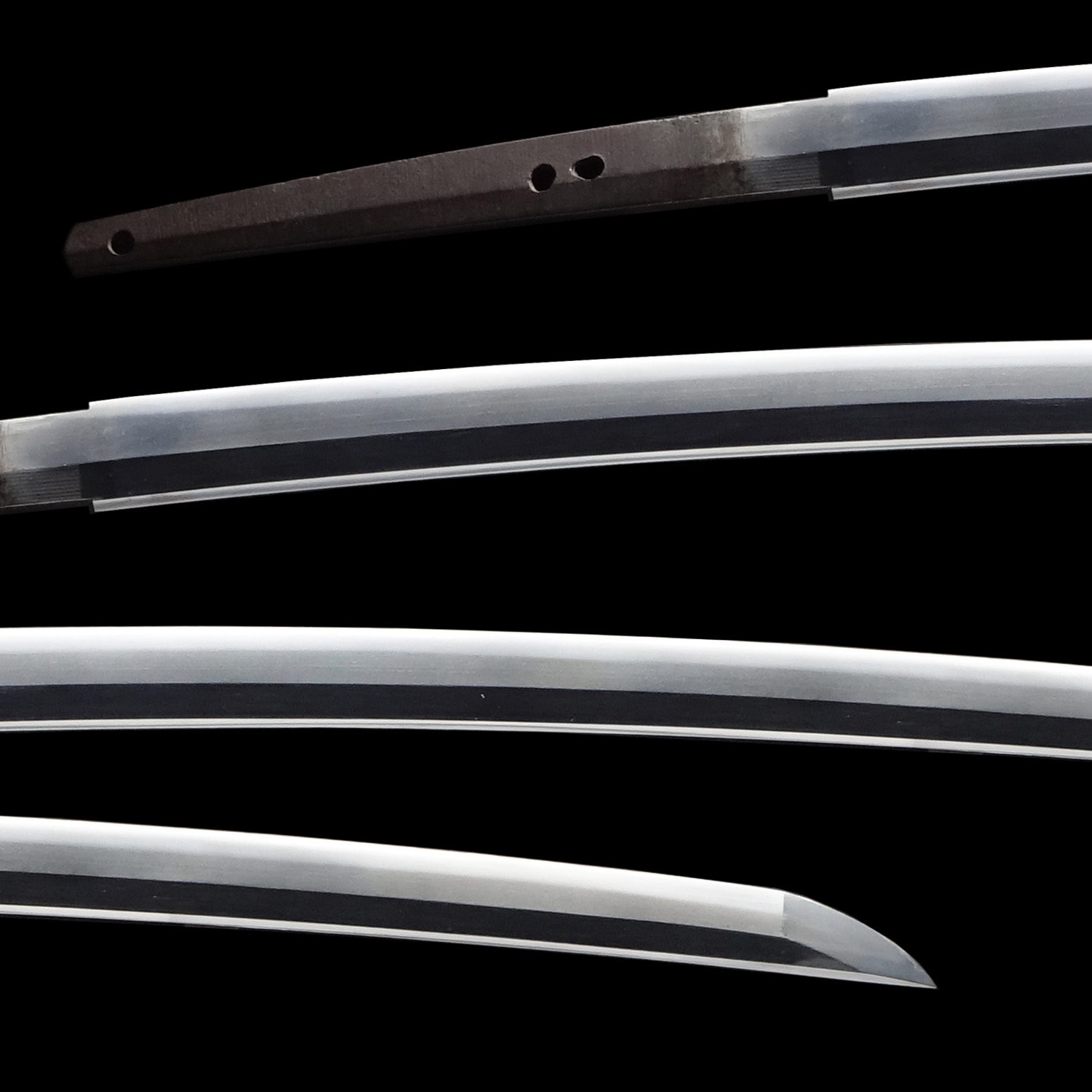

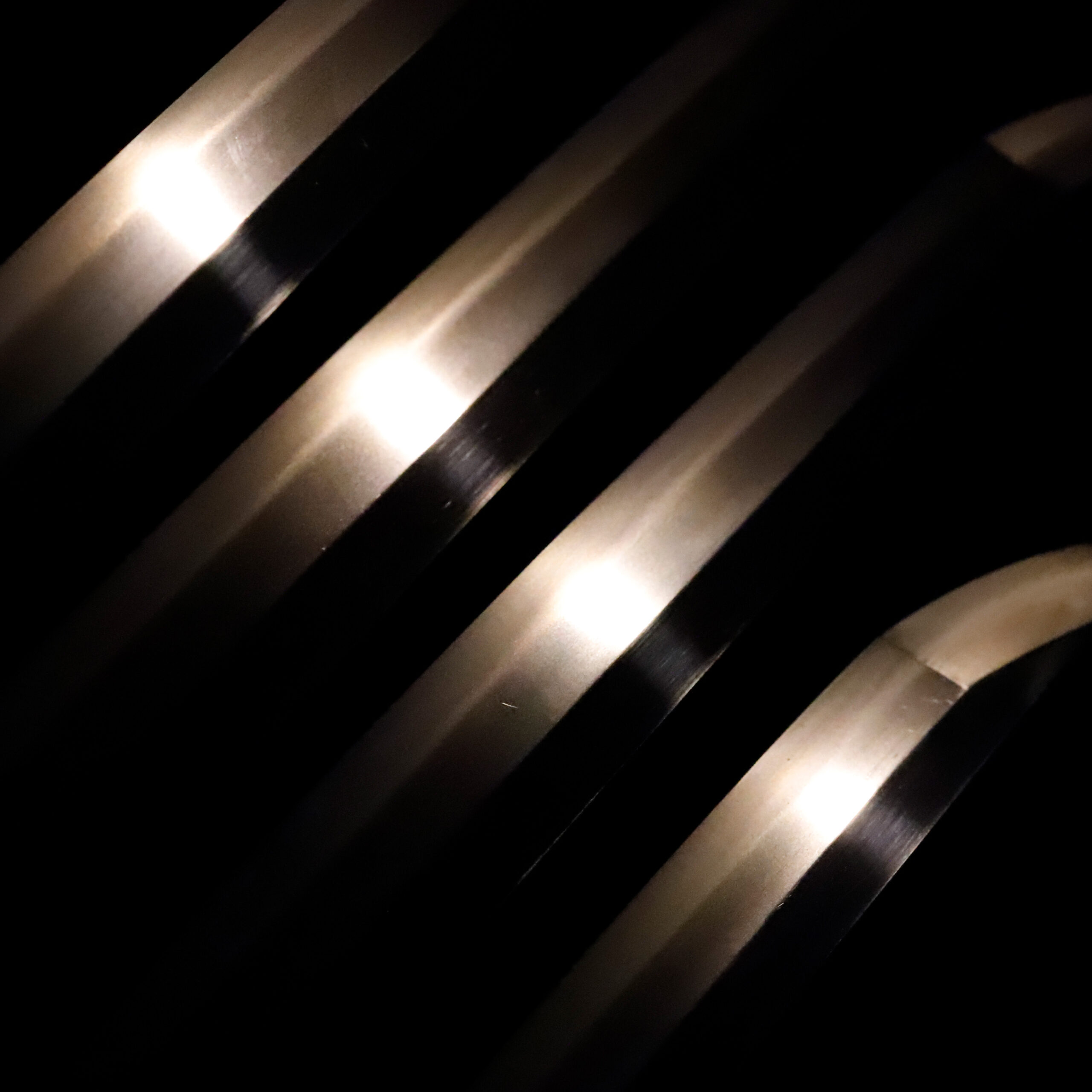
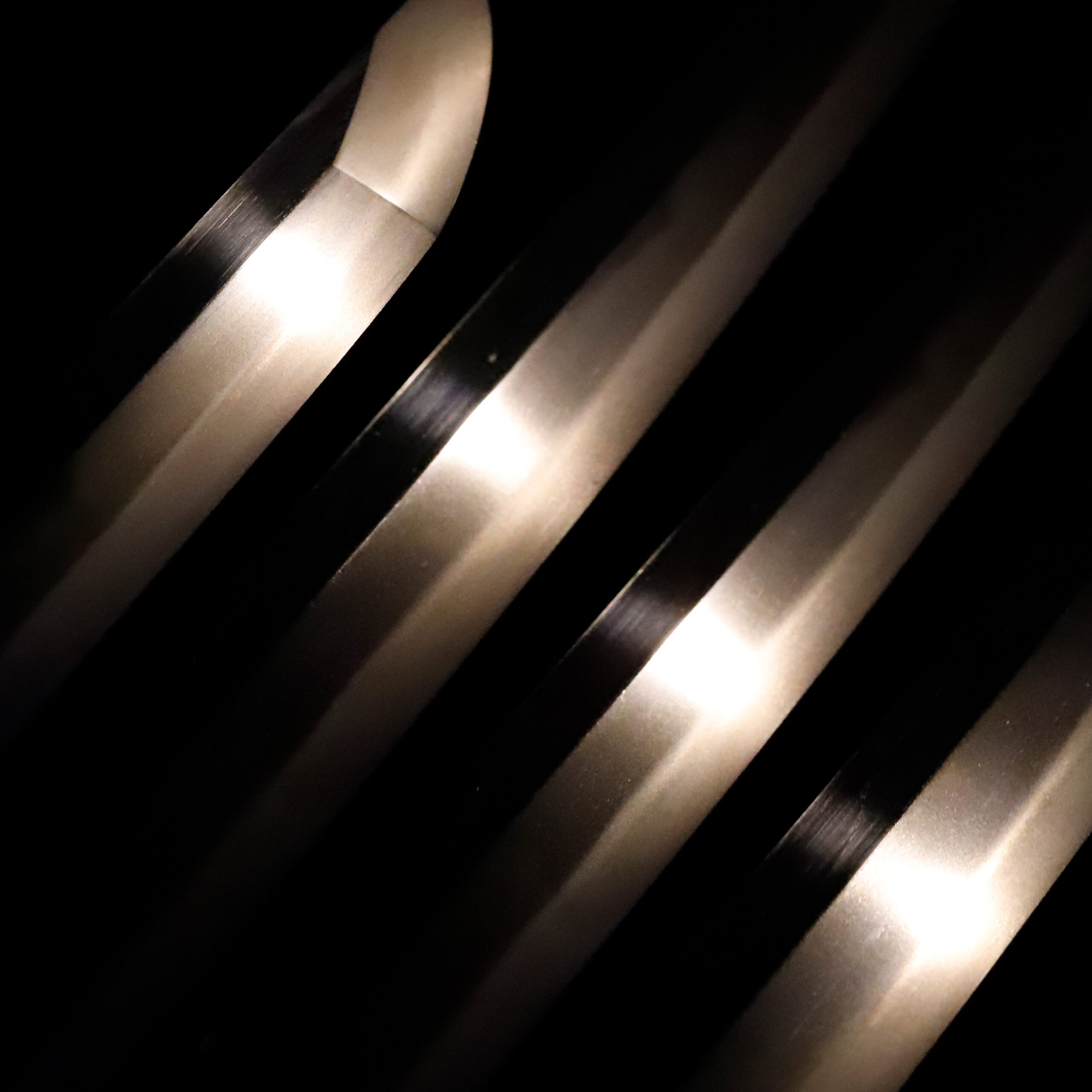
-Wakizashi
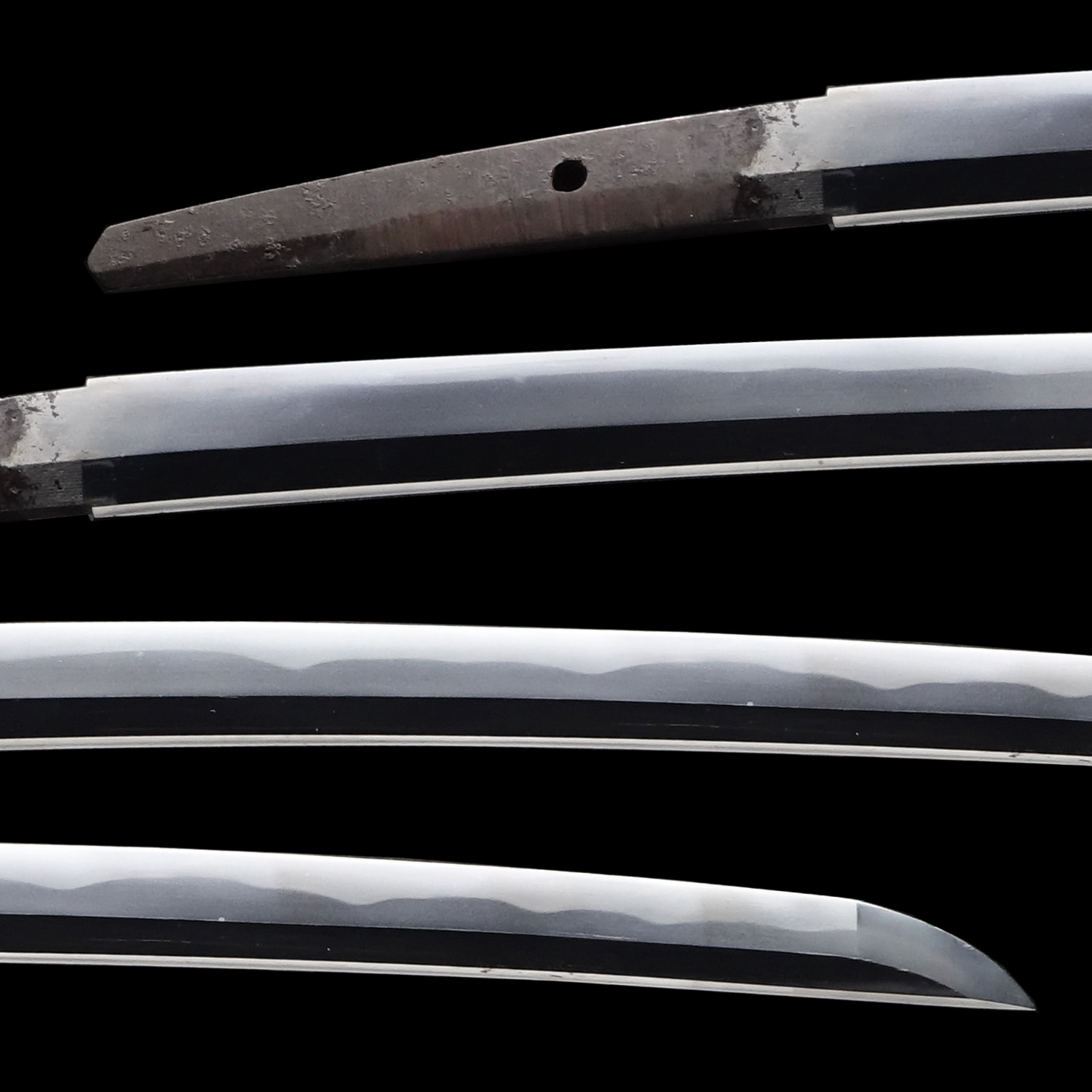

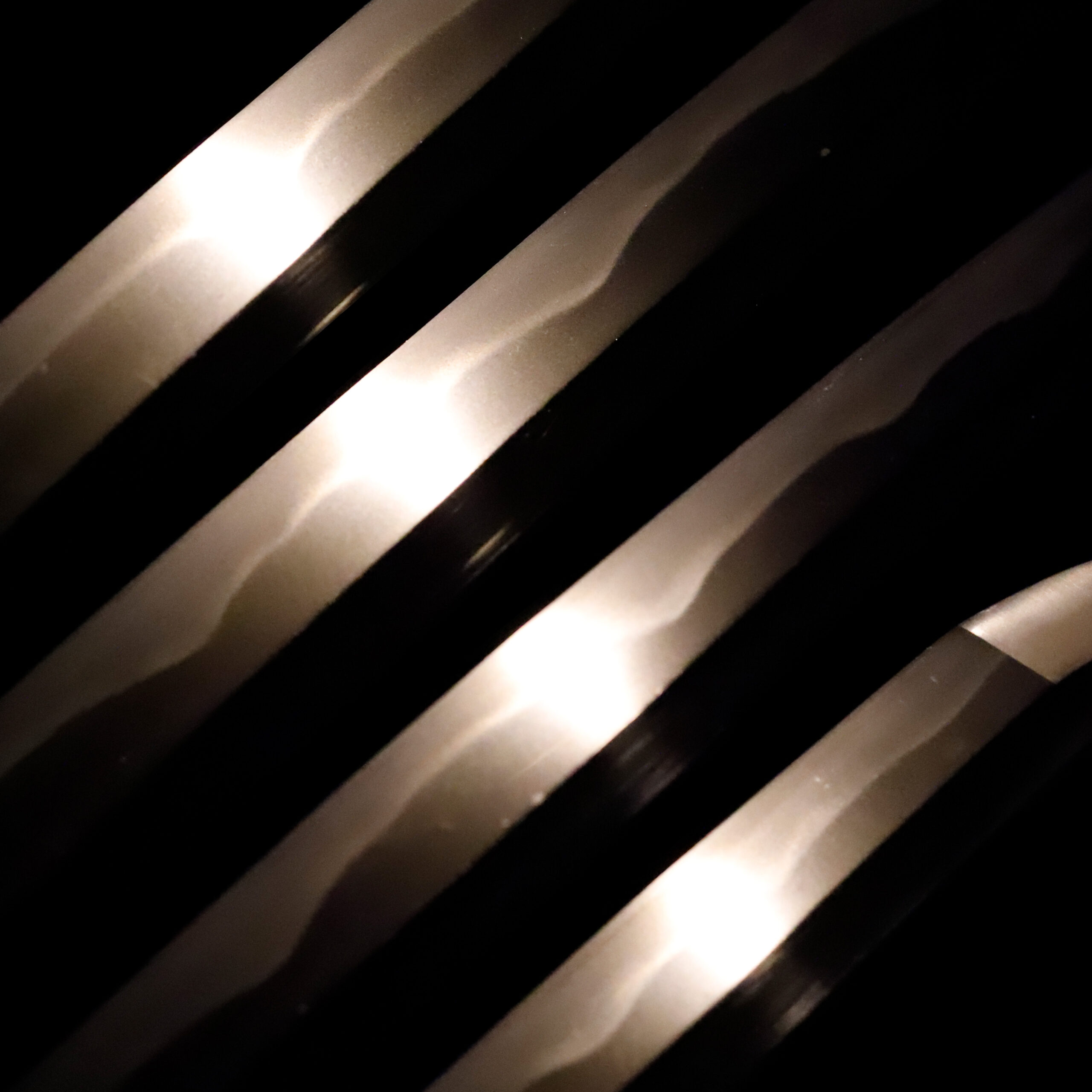
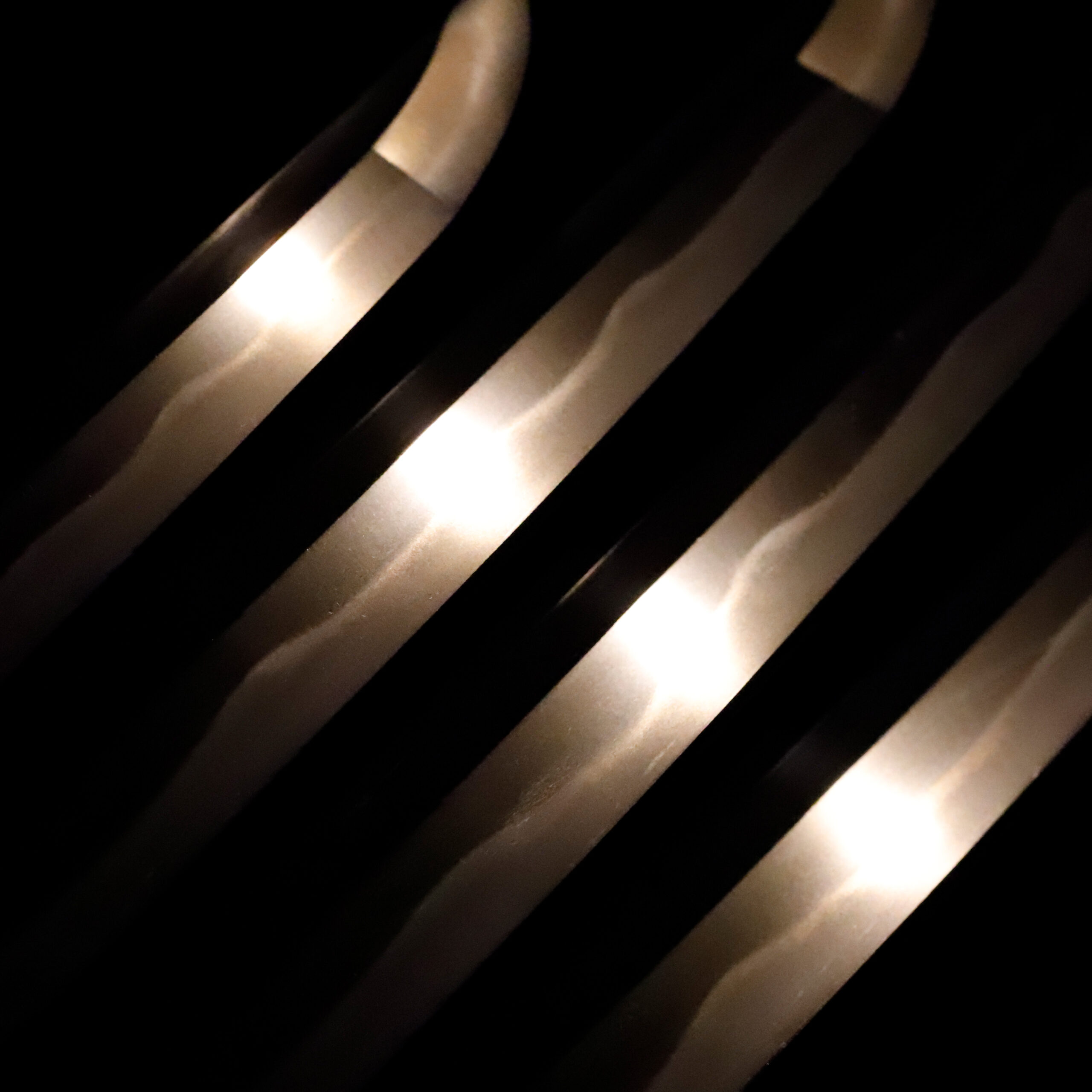
Nakago:Nakago is the tang of the Japanese sword.
Japanese swordsmiths left the black rust on the tang because it prevents red rust while the tang is in its handle. And the discoloration of the tang was created over time, and it is a great indicator for a Japanese sword specialist to estimate when the sword was forged.
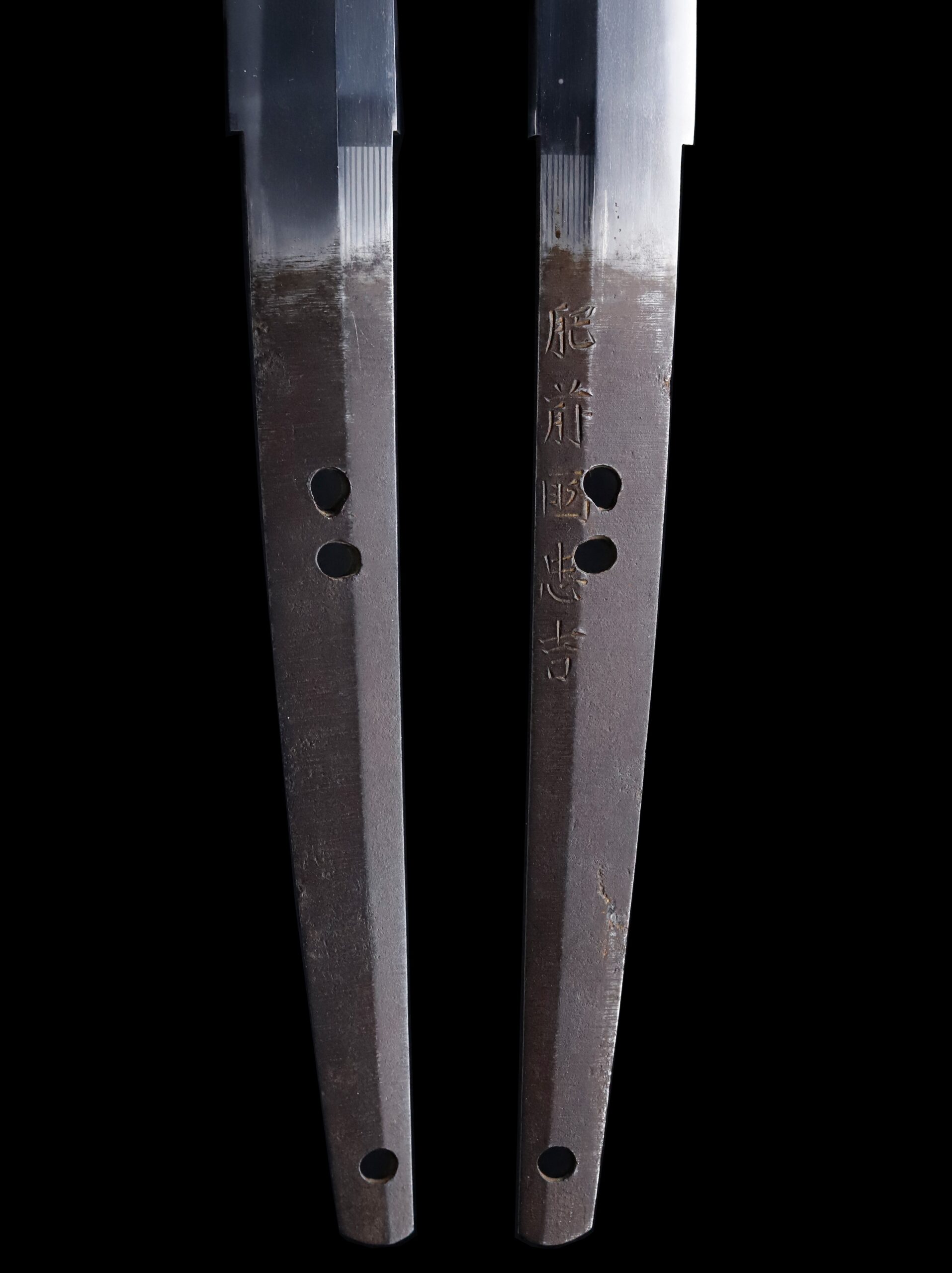
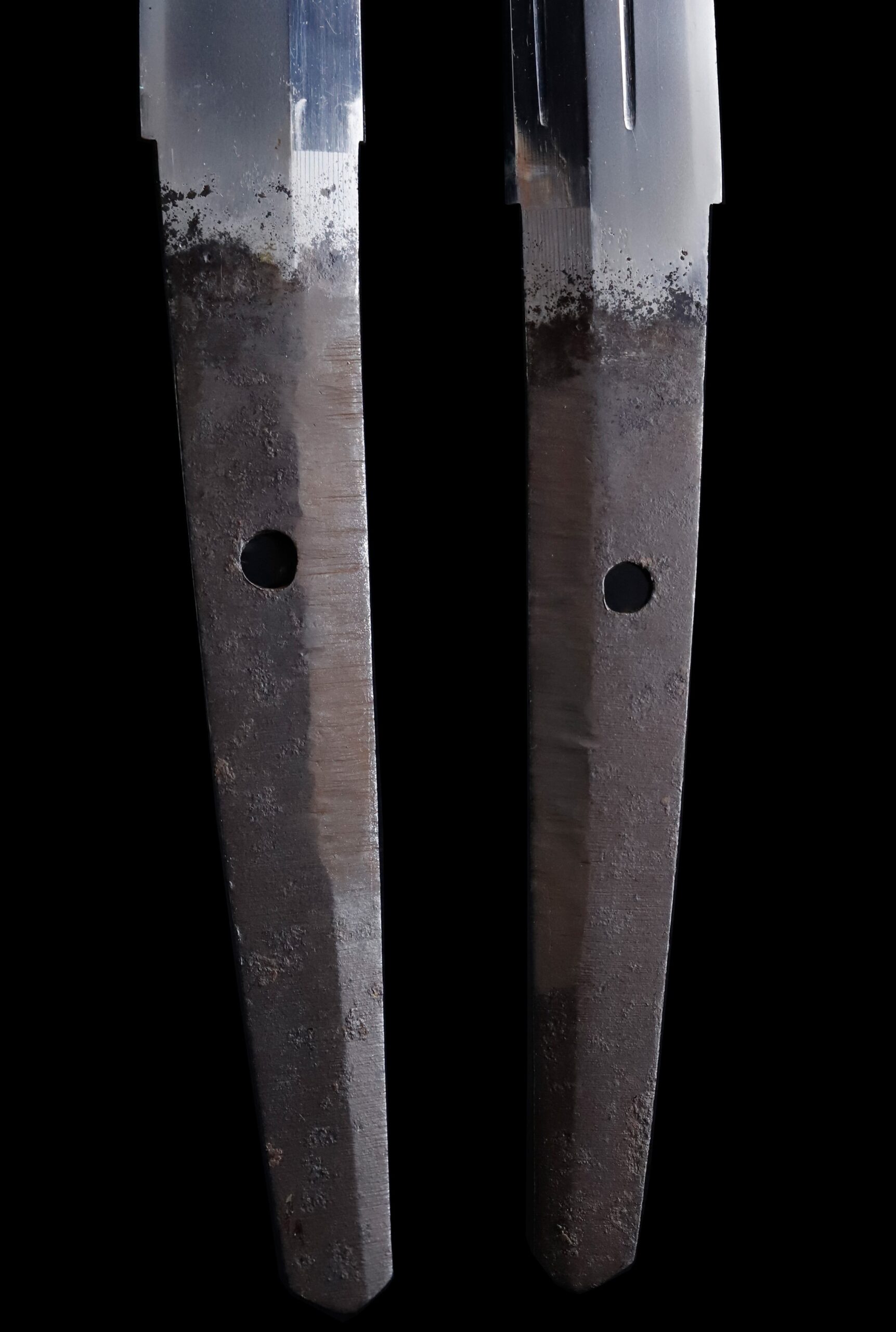
Koshirae: Koshirae is the mounting of the Japanese sword. There are several parts that consist of Koshirae such as Saya(Sabbard), Tsuka( Handle), Tsuba(Handguard).
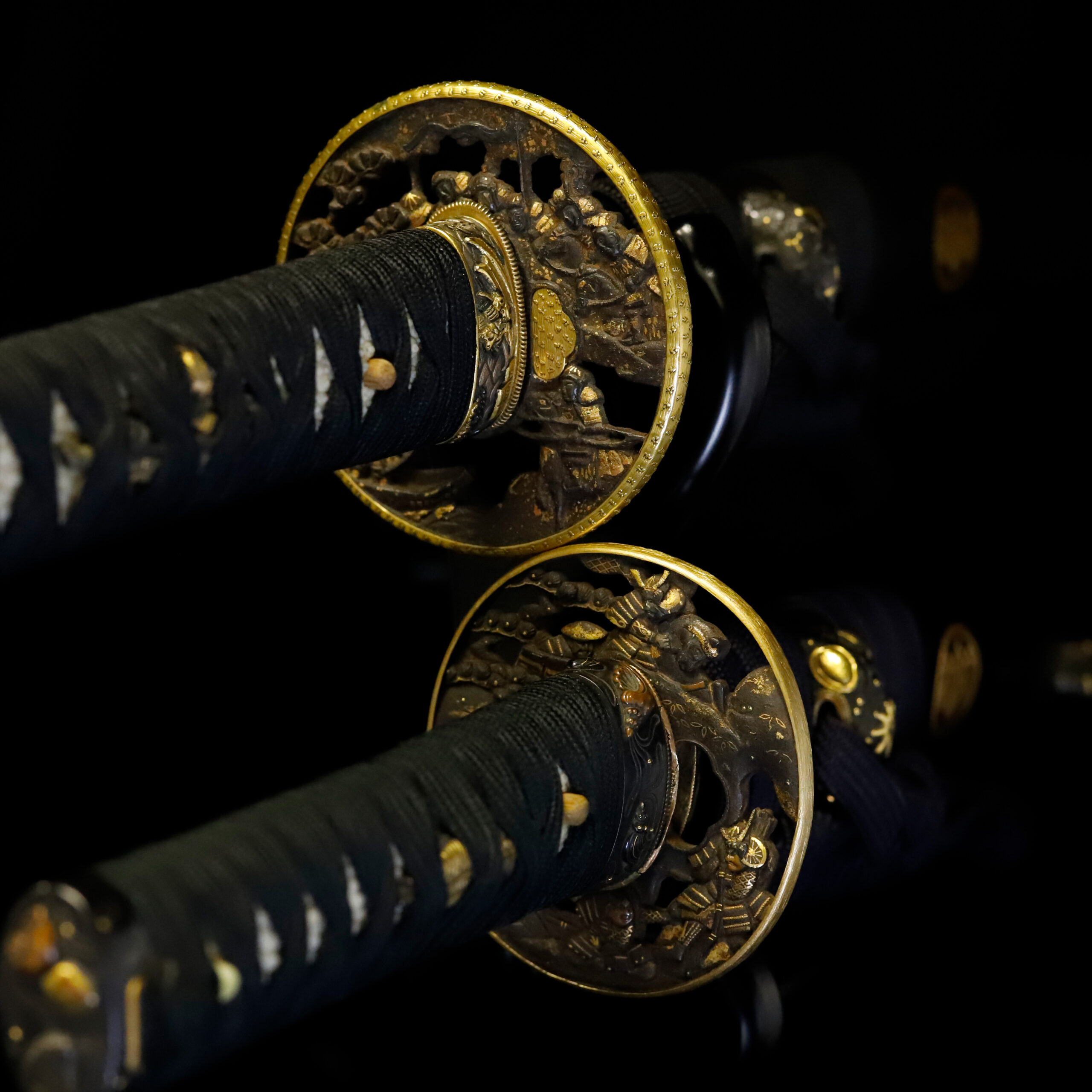
Fuchi-Kashira:A pair of matching sword fittings that cover the upper and bottom parts of its sword hilt.
The design of this Katana’s Fuchi Kashira is the Gunsen Zu (軍船図). It depicts ships used in naval battles. You could find Samurai warriors heading into battle on ships. And this theme is the same with this Katana’s Menuki as well. Uniquely, the Kashira part is designed with a Kabuto (兜, Samurai helmet) motif. This helmet has a gorgeous appearance of Suji Kabuto (筋兜) and has a dragon-designed front decoration. As described below, this Daisho Koshirae has a principal theme: Kassen Zu (合戦図). It depicts a scenery of a battlefield. Samurai warriors wear armor and bring weapons. They have stern expressions, and their brave appearance on the battlefields are expressed in detailed sculptures. Please continue to enjoy the following descriptions.
The Wakizashi’s Fuchi Kashira is decorated with seashell patterns. Various types of shells, such as snails and bivalves, are designed. It is called the Kai Dukushi (貝尽くし). This pattern is a combination of different types of seashells. Bivalves, especially clams, their shells cannot be combined with any other clam’s frame; therefore, its pattern represents happy marriage.
Seashell is called Kai (貝) in Japanese. Because of its pronunciation, the seashell has another meaning. There is a word Yarigai (やりがい, worthwhile). As a part of this word has the same accent as Kai (貝 is read Gai in some cases), Japanese people found this meaning. Also, since seashells are hard and combine only with their pair, people thought it represented a robust defense. Due to these meanings that inspire warriors who go to the battlefields, Samurai might have loved this motif. It has often been combined with a seaside scene or wave pattern. We think this design matches well with Katana’s Fuchi Kashira Gunsen Zu theme.


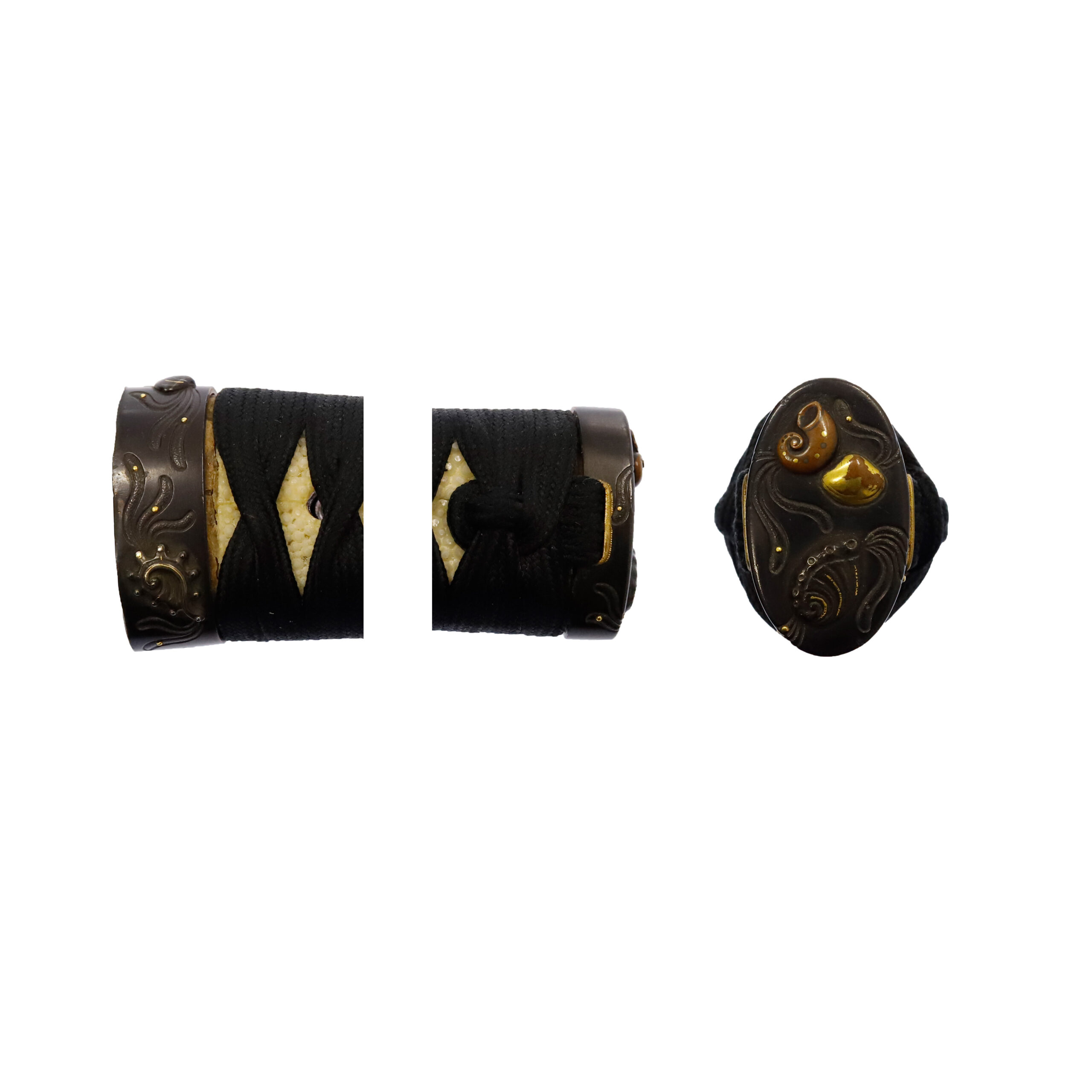
Tsuka and Menuki:Tsuka is the handle of the Japanese sword and Menuki is its decoration.
As mentioned above, this Katana’s Menuki has the same theme as the Fuchi Kashira. In addition, you could find this theme on the Kojiri (鐺, a metal fitting that protects the tip of a scabbard).
About Wakizashi’s Menuki, although we cannot see its entire shape, we could find a small chrysanthemum flower. And it seems golden paint was initially applied to its surface. A long time ago, the chrysanthemum was used as a medicine for obtaining a long life in the continent, and it was brought to Japan with this thought in the Nara period (648-781). Chrysanthemum symbolizes autumn, and people have greatly appreciated it since ancient times. As its petals form radially, the chrysanthemum has been likened to the sun. That is why this flower pattern is treated as the symbol of perpetual youth and longevity or good health. These ideas might have inspired this Menuki.
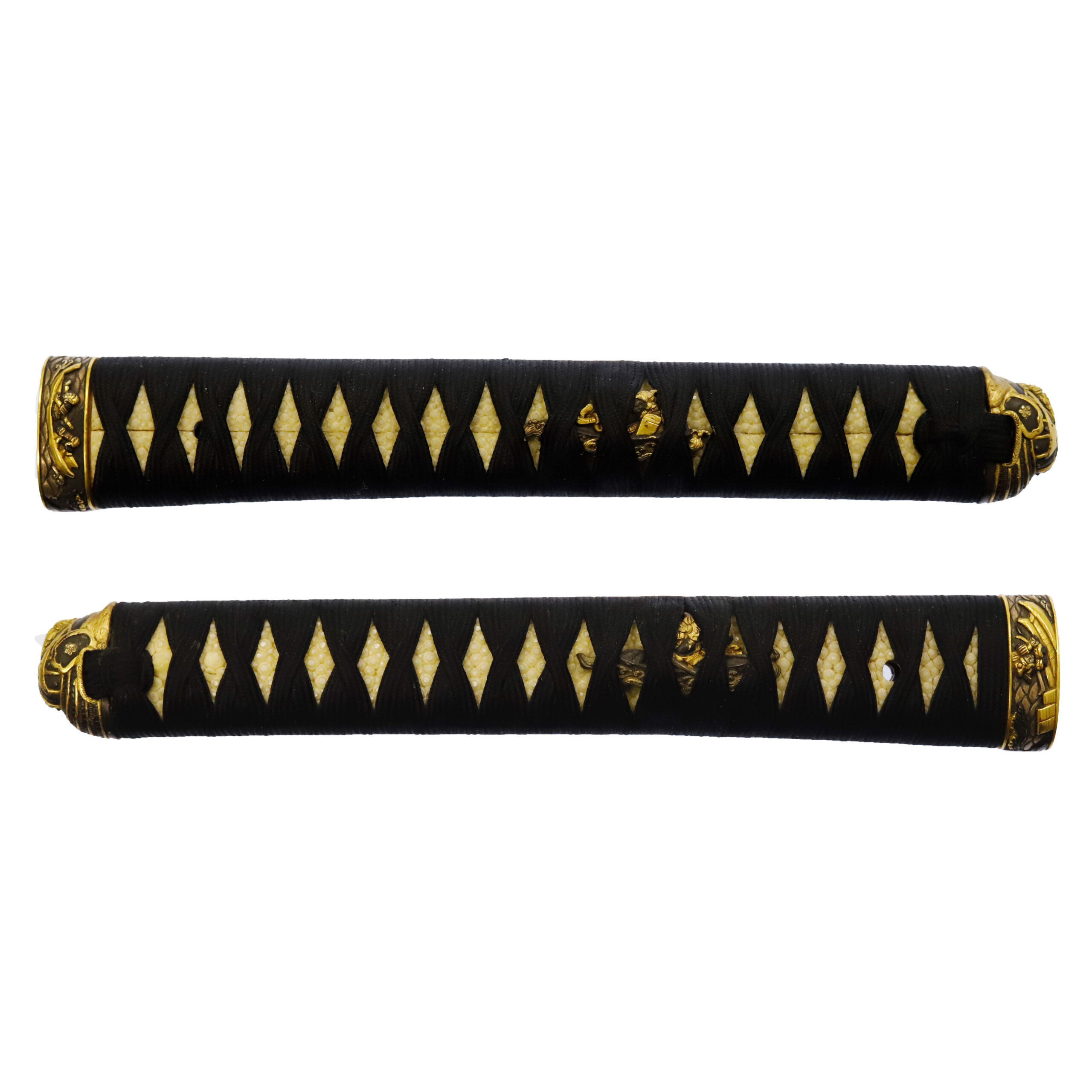

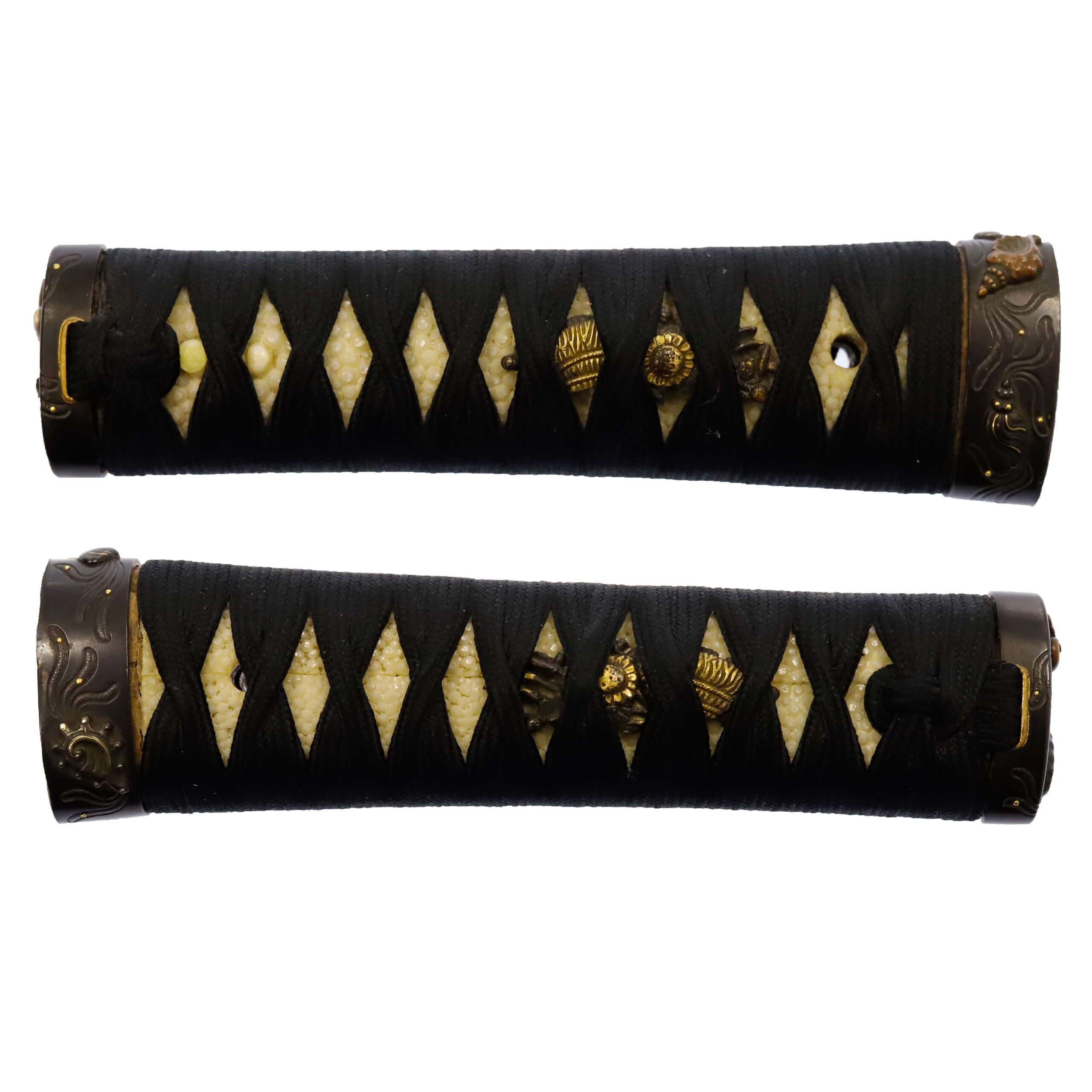
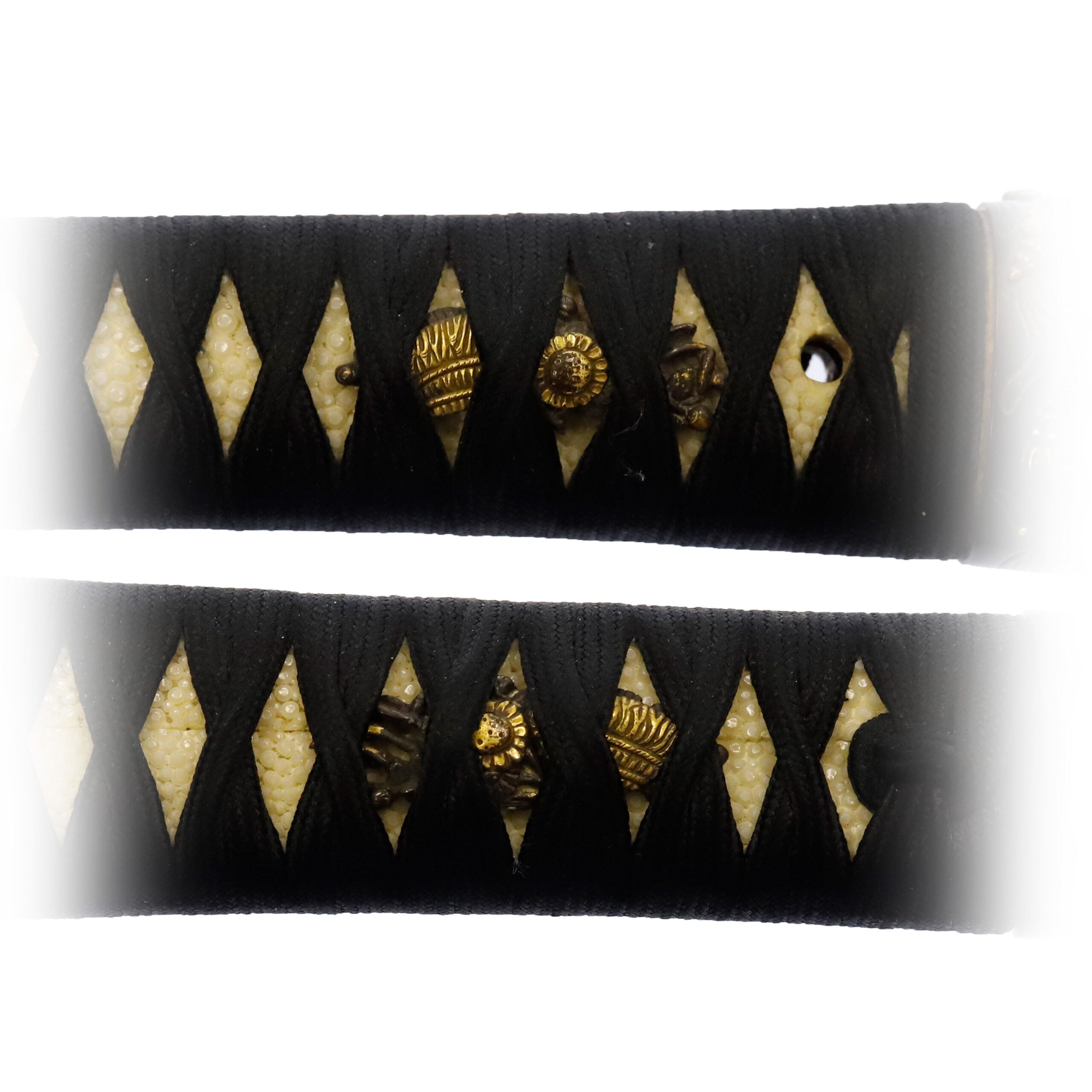
Tsuba and Habaki:Tsuba is the handguard for the Japanese Sword and Habaki is the equipment to make the blade not touch its scabbard inside. It prevents the blade from getting rusty and chipped.
You see the figure of fighting Samurai warriors. Both Tsubas have the same theme: the Genpei Kassen (源平合戦). It does not refer to one battle. This is a collective term for the civil wars heated in various parts of the country that continued over six years from 1180 until 1185. It is also called the Jishou Juei-no Ran (治承・寿永の乱). This was the battle between the Minamoto (源) clan (Genji family) and the Taira (平) clan (Heike family). By the call of Mochihito Ou (以仁王), many Samurai raised armies to overthrow the Taira family. It was the trigger of this protracted conflict. Mochihito Ou was unfortunately beaten by the Taira family and passed away in 1180. However, after that, Minamoto family side Samurai defeated the Taira side armies one after another. Finally, the Minamoto side won the battle and overthrew the Taira clan in 1185 at Dan-no Ura (壇ノ浦). It was the final battle of the Genpei Kassen, which led to the destruction of the Taira clan, who reached the height of glory.
You would find the engraved inscription on the front of Wakizashi’s Tsuba. It is written as follows: 藻柄子入道 宗典製 (Mogarashi/Souheishi Nyudoh Souten Sei). Therefore, it shows this Tsuba’s maker is Mogarashi/Souheishi Nyudoh Souten (藻柄子入道 宗典). It is said he worked actively in the middle of the Edo period. He lived in Hikone (彦根) area, Oumi-no Kuni (近江国, today’s Shiga prefecture). He was good at the Takabori Iroe (高彫色絵) technique and originated the Hikone-Bori (彦根彫) style. He trained many disciples and played an active role in his longevity over 75 years old. The second Souten was the first’s son. He followed the first’s designs and created lots of excellent Tsubas. It is said many fake Souten Tsubas were made; it shows his works were highly appreciated.
As additional information, please focus on the Mimi (耳, edge) part of each Tsuba. Both Tsubas’ Mimi parts are framed with golden metal. This decorative technique is called the Kin-Fukurin (金覆輪). It gives a gorgeous beauty to works, as seen in these Tsubas. It also has practicality, such as preventing the wear of the edge part. Also, it prevents wear and tears on the Kimono (着物, traditional Japanese costume) if the edge damages it by touching the cloth.
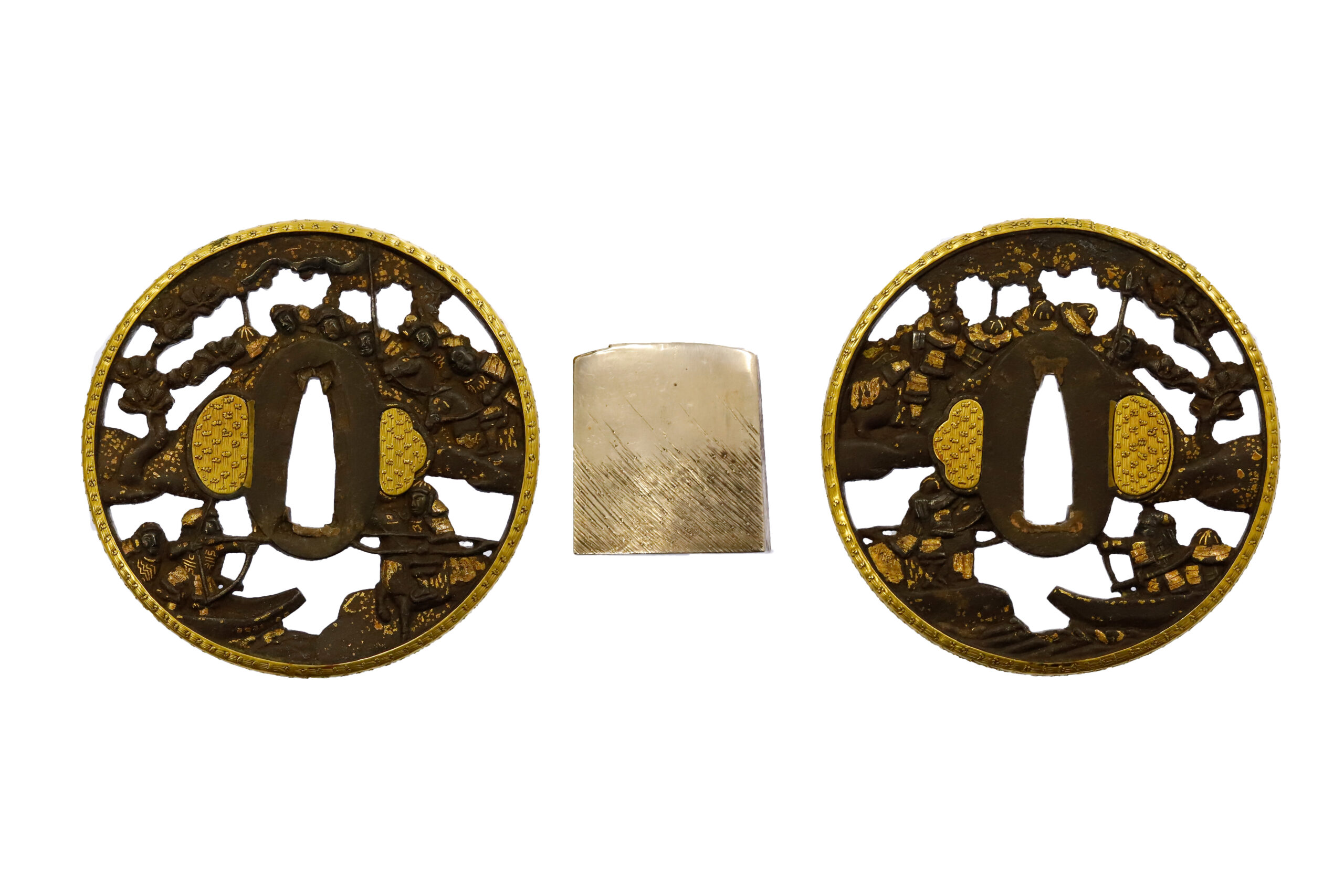
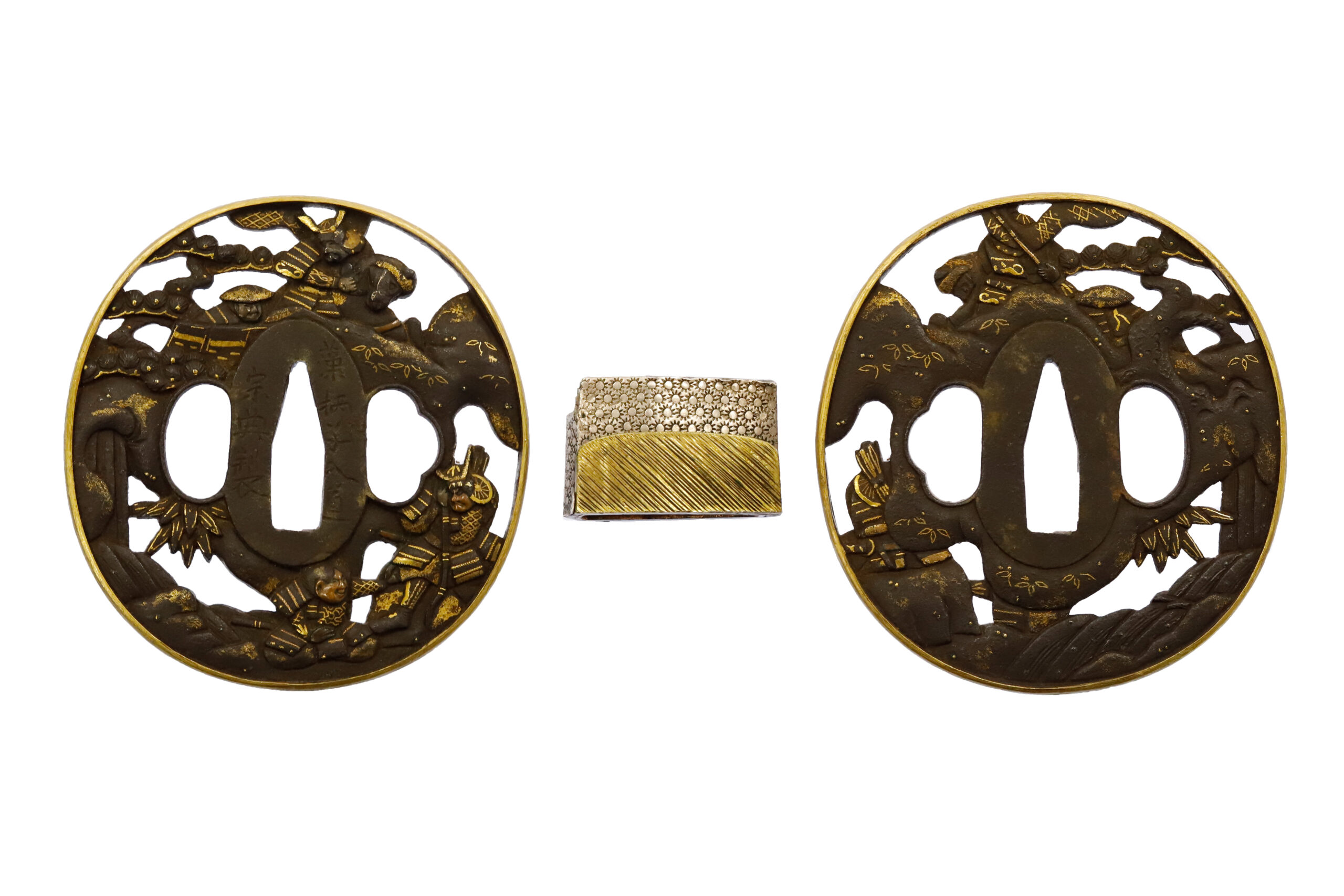
Saya: Saya is the scabbard for the Japanese sword.
Pine and wave patterns are arranged alternatively on both scabbards. Also, you would find a golden crest. It is the Maru-ni Gosan Kiri (丸に五三桐), and we believe it was designed here as a family crest. The Kiri (桐, paulownia) pattern is generally composed of three standing straight inflorescences and three leaves. The number of blooming flowers at each inflorescence means the ranks of this design. The Gosan-no-Kiri (五三の桐) pattern is a popular design that the paulownia motif is used. This pattern was once used by the imperial family and people in authority at that time. Today, it is permitted to use by ordinary households and is appreciated as their family crests. According to a tradition, the Houou (鳳凰, Fenghuang, a kind of sacred beast) rests its wings at the paulownia tree; therefore, it has come to be regarded as a holy plant.
About the pine tree pattern, since pine trees keep their green color throughout the years by withstanding severe heat and cold, people thought this plant pattern represents eternal youth. Furthermore, its color is called Tokiwa-Iro (常盤色, evergreen trees’ dark green color with brown), and pine trees have another name “Tokiwa-Gi (常盤木).” Tokiwa means immutability, so Tokiwa-Iro is a color that praises green with a wish for longevity and prosperity.
And the wave pattern is intentionally drawn here, considering the combination with the theme of other sword mountings: Kassen Zu and Gunsen Zu. Also, this design itself has the following meanings. As waves’ movements continue endlessly, the wave pattern represents eternity, immortality, longevity, birth, etcetera. Also, since tides repeatedly change the shape and terrain of rocks, some people hoped for a strong will by using this motif. People used this pattern wishing for an indomitable spirit to rechallenge time and time without giving up. If we look at it this way, we can see that each design is deliberately placed there.
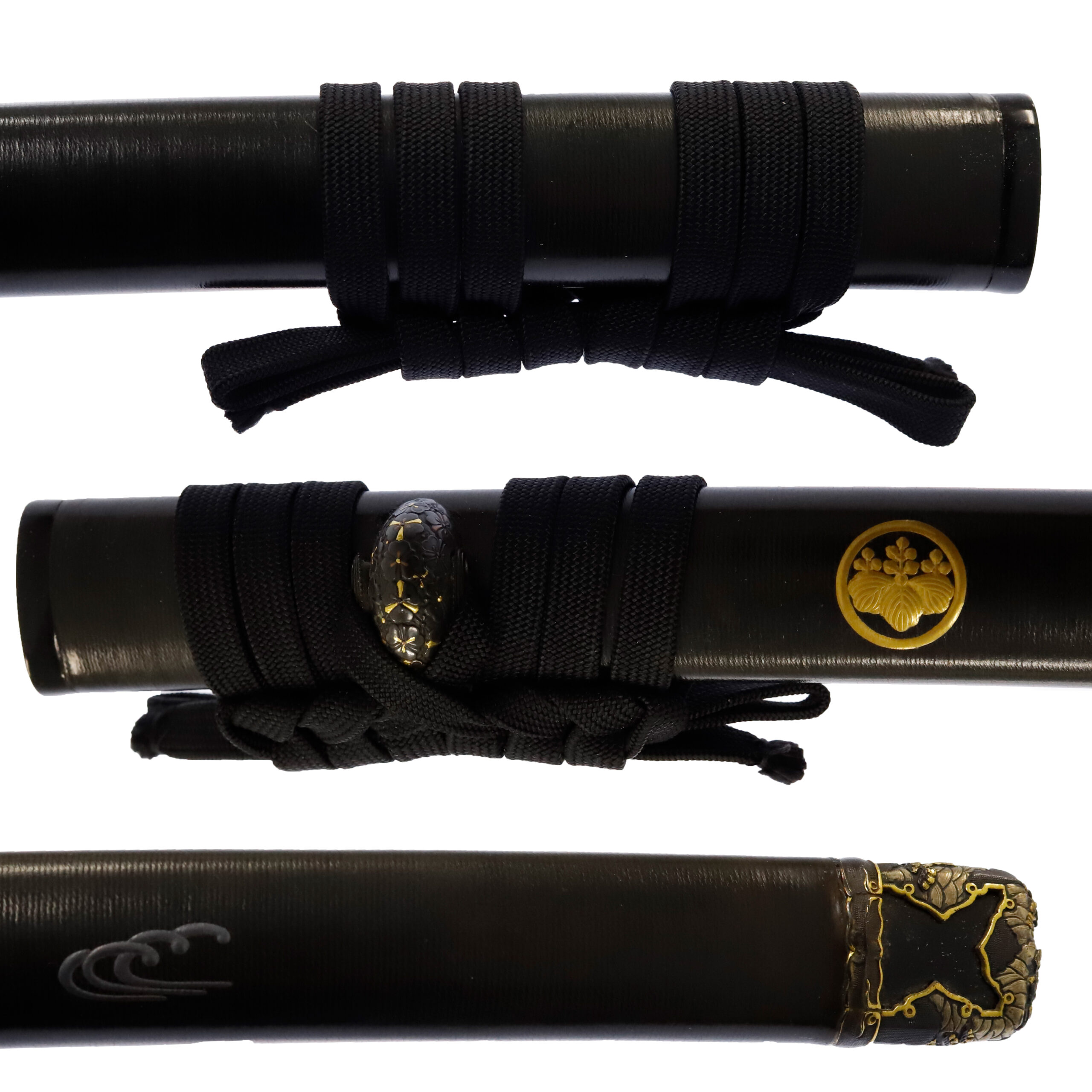
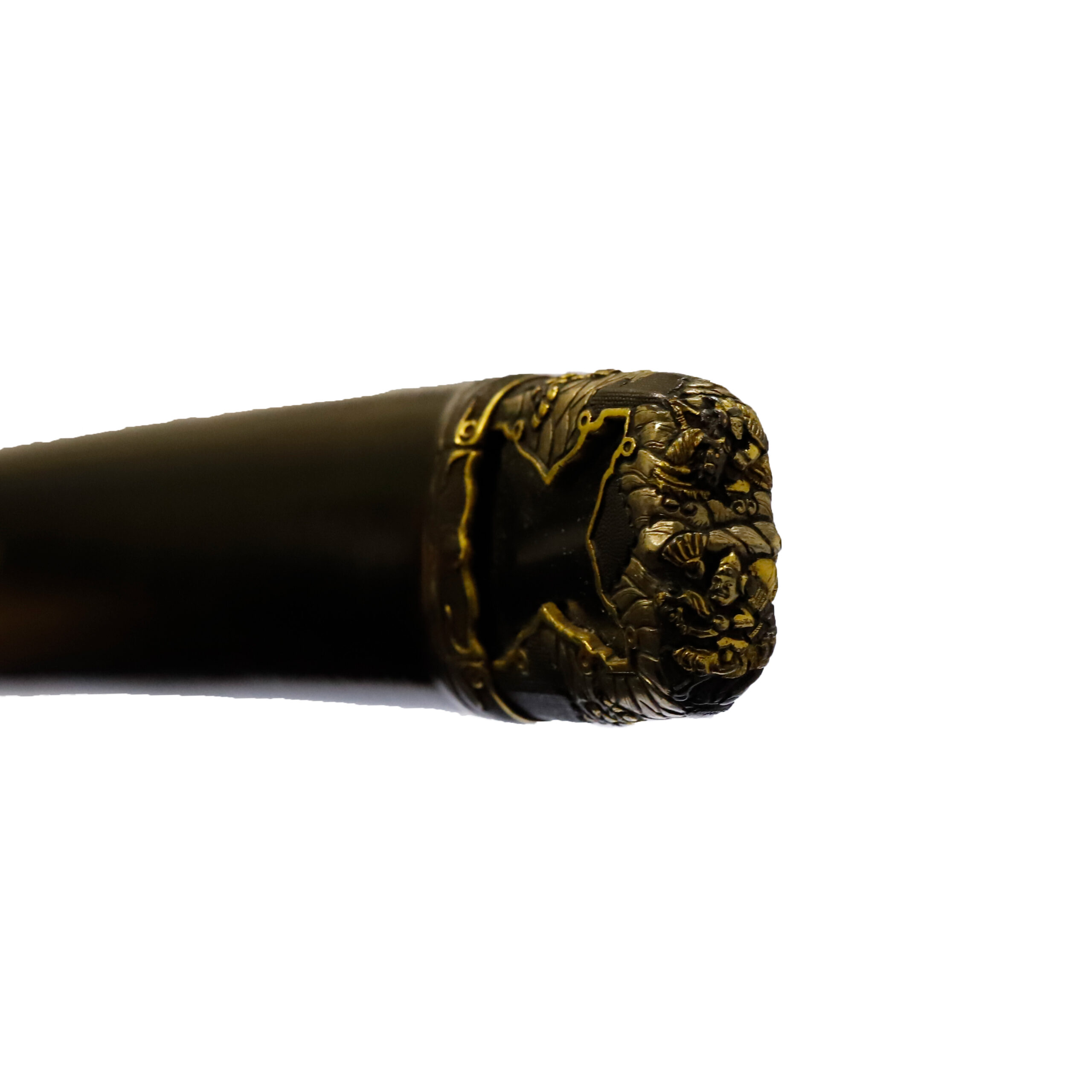
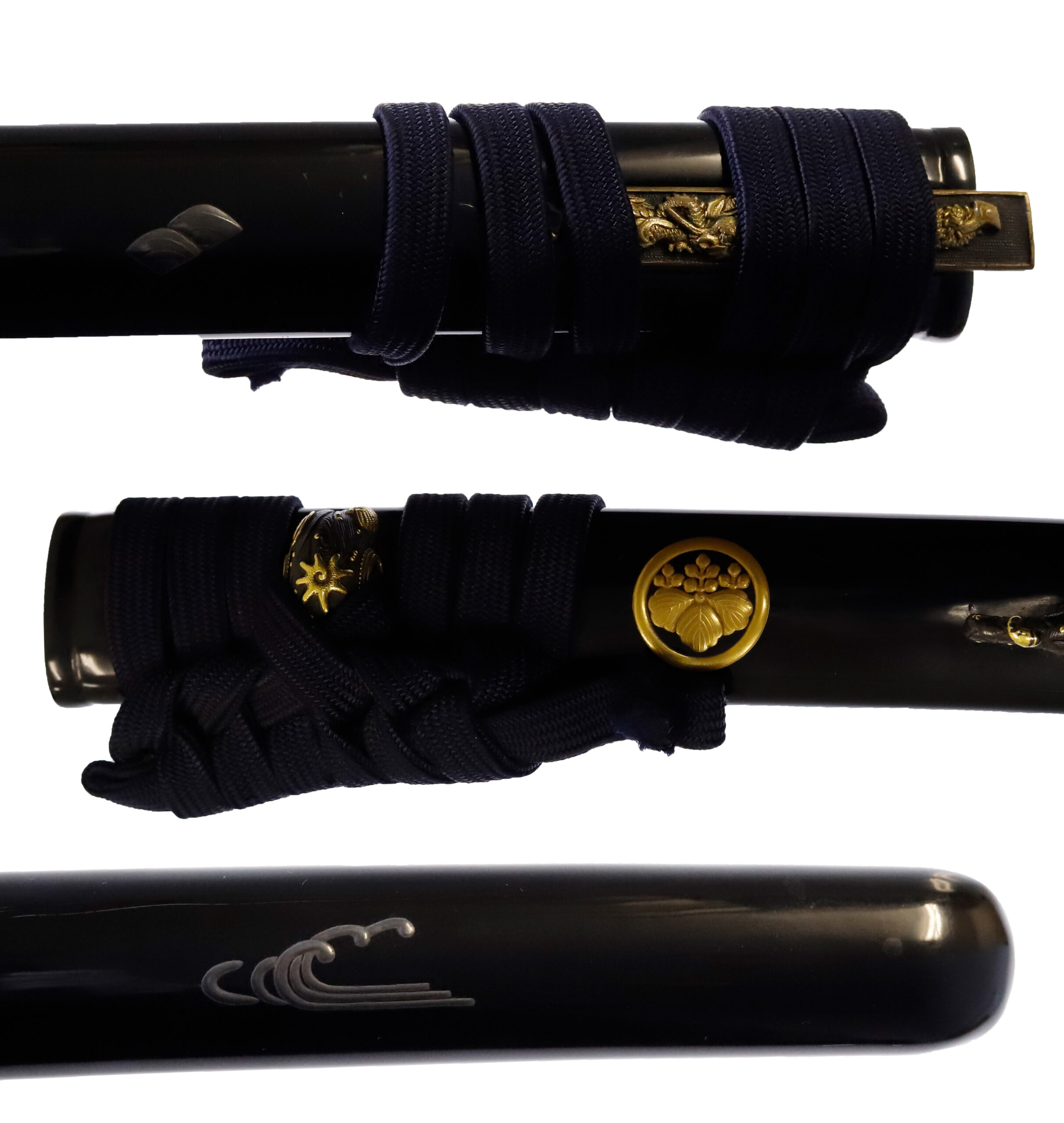
Kozuka:Kozuka is a small knife stored in Kozuka Hitsu(groove of the sheath of the Japanese sword).
A Kozuka is attached to the Wakizashi’s handle, and a Kogatana (小刀, small knife) is stored. The dragon is designed and colored with golden paint. If you focus on this dragon’s hand, you will find that it brings a ball-shaped object in its hand. It is the Nyoi Houju (如意宝珠, Cintāmaṇi); a fantasy jewel that fulfills any desire and gives out treasure, clothes, food, and drinks. Moreover, it heals illness and suffering, removes evils, purifies muddy water, and prevents disasters. It is said this magical item is taken from the brain of the dragon king.
Initially, the dragon was an imaginary creature found in ancient foreign traditions or myths. Furthermore, it is regarded as a symbol of auspicious signs. Its body is likened to nine animals: antlers are deer, the head is a camel, eyes are demons, the neck is a snake, the belly is the Mizuchi (蛟, a mythical animal in Japan that looks like a snake and has a horn and four legs), scales are fish, claws are falcons, palms are tigers, and ears are cows. It was thought that the dragon would reign at the top of all animals because of its odd-looking appearance. The dragon design is often seen in sword mountings. We imagine lots of Samurai favored this dignified beast motif.
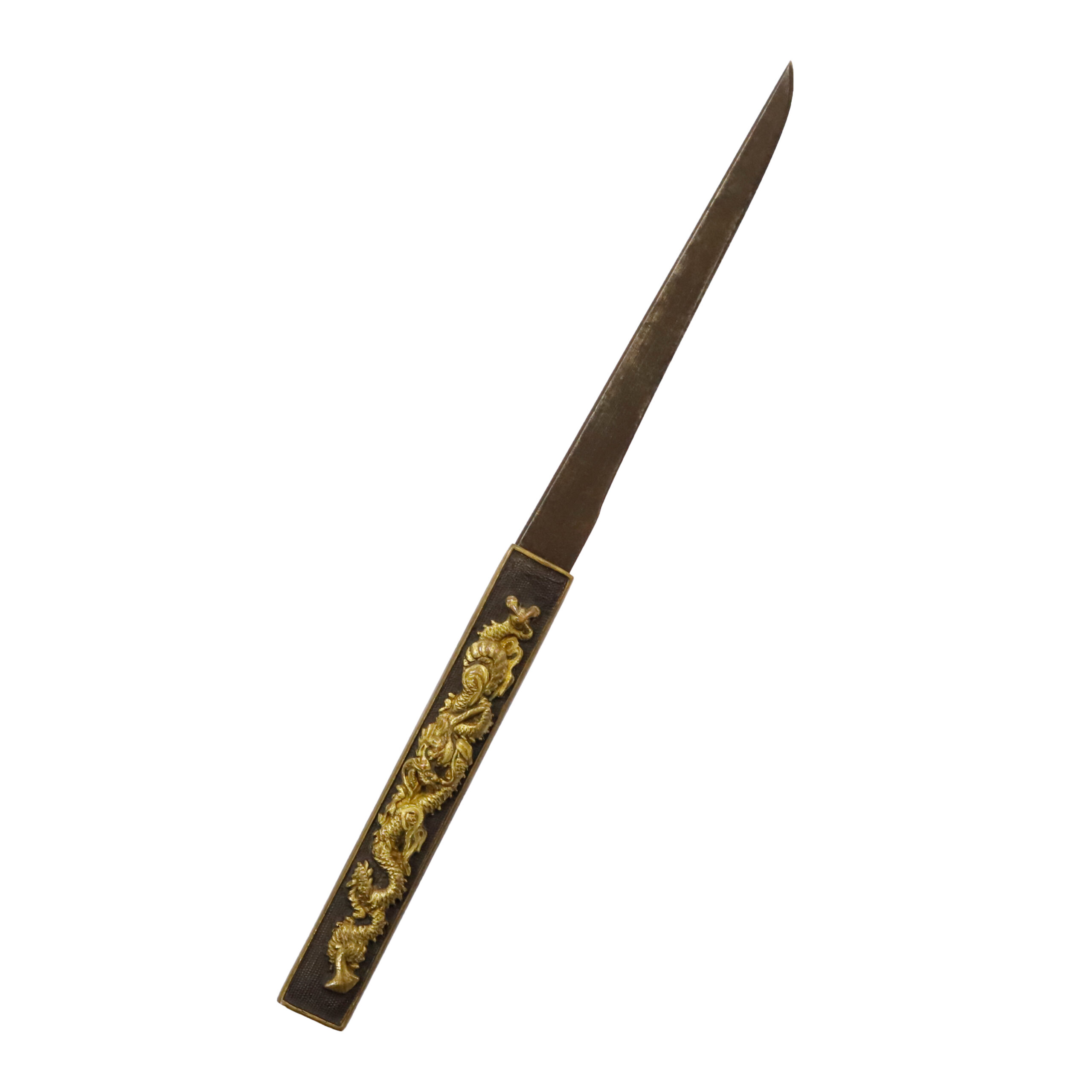
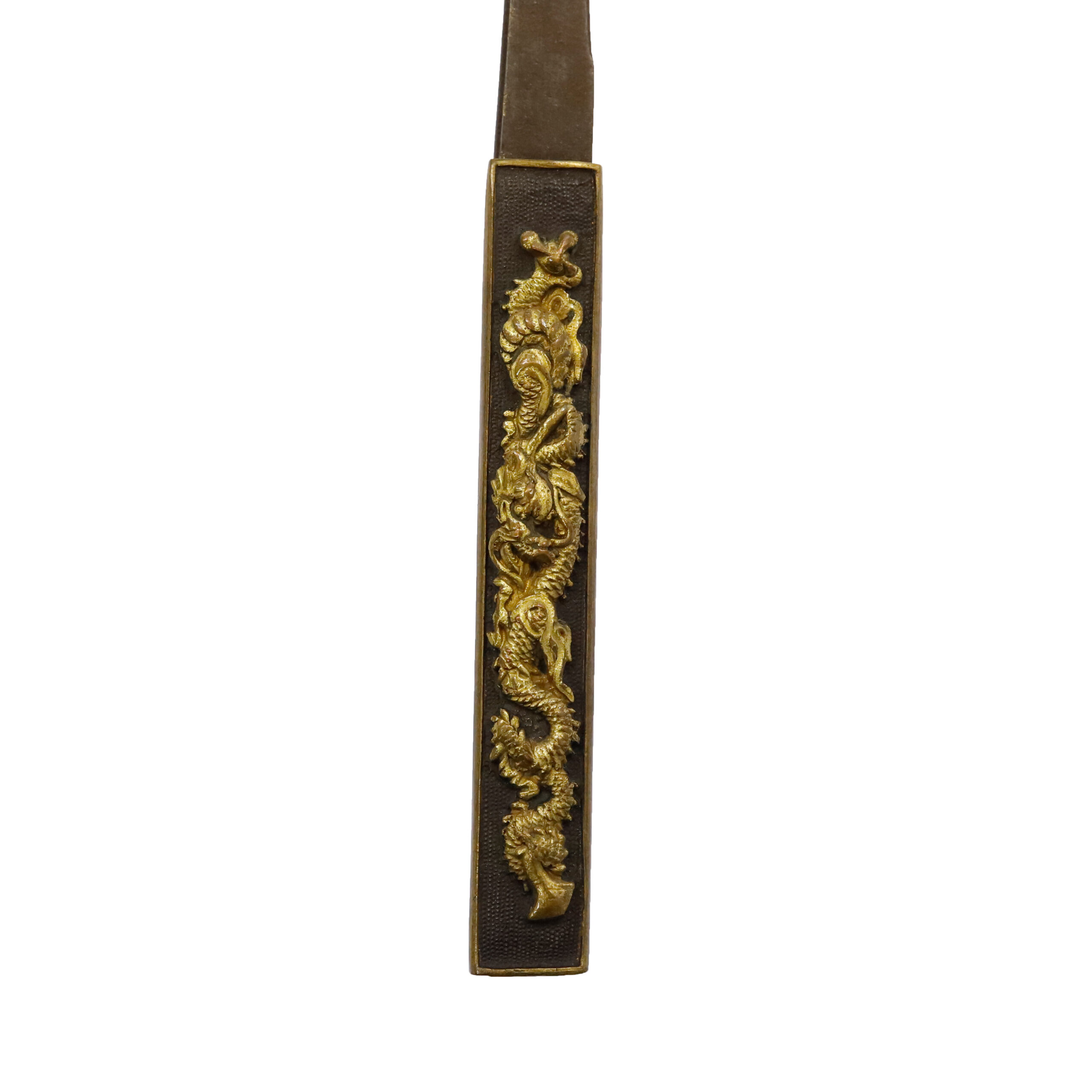
Authentication Paper:NTHK-NPO Kanteisho Certificate for Katana, Wakizashi and Koshirae
NTHK, also known as NPO Nihon Touken Hozon Kai, is the oldest organization for sword authentication of Japanese swords in modern times. It was established in 1910 during the post-Samurai era. They authenticated the Katana and the Daisho Koshirae on October 16th in the 4th year of the Reiwa era (2022) and the Wakizashi was authenticated on December 18th in the forth year of the Reiwa (2022). We are expecting to receive the authentication paper for the Wakizashi in next January 2023. The purchaser will receive these original certificates as well. We can also translate what is written into English and make a PDF file for your record if you request.



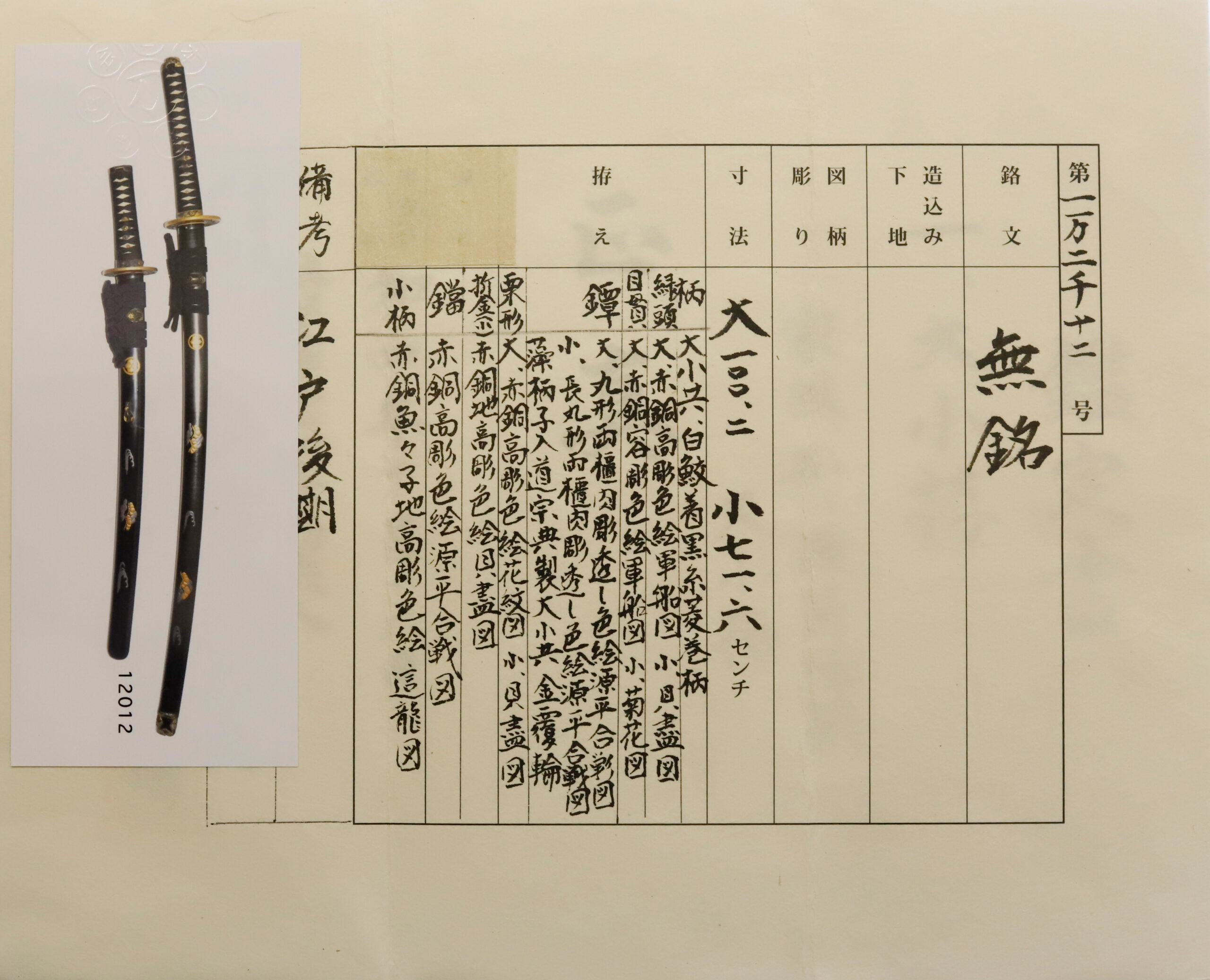
Registration Number : Kouchi 5130-Tokyo 325680
The Board of Education in Kouchi prefecture issued a registration paper for the Katana blade and that in Tokyo issued one for the Wakizashi. It is called Jyu Token Rui Torokusho(銃刀剣類登録証). Bunkacho(The Agency for Cultural Affairs) acknowledges a Japanese sword with this paper as a work of art.
The sword needs to be traditionally hand-forged and made of Tamahagane carbon steel to be registered in the system. With this paper, its owner in Japan can legally own an authentic Japanese sword. Based on this registration number, we will apply for its export permit.
This paper will need to be returned to the board of education when the sword is being shipped abroad, but you can receive a copy of it. An English translation of this registration paper is available on request.

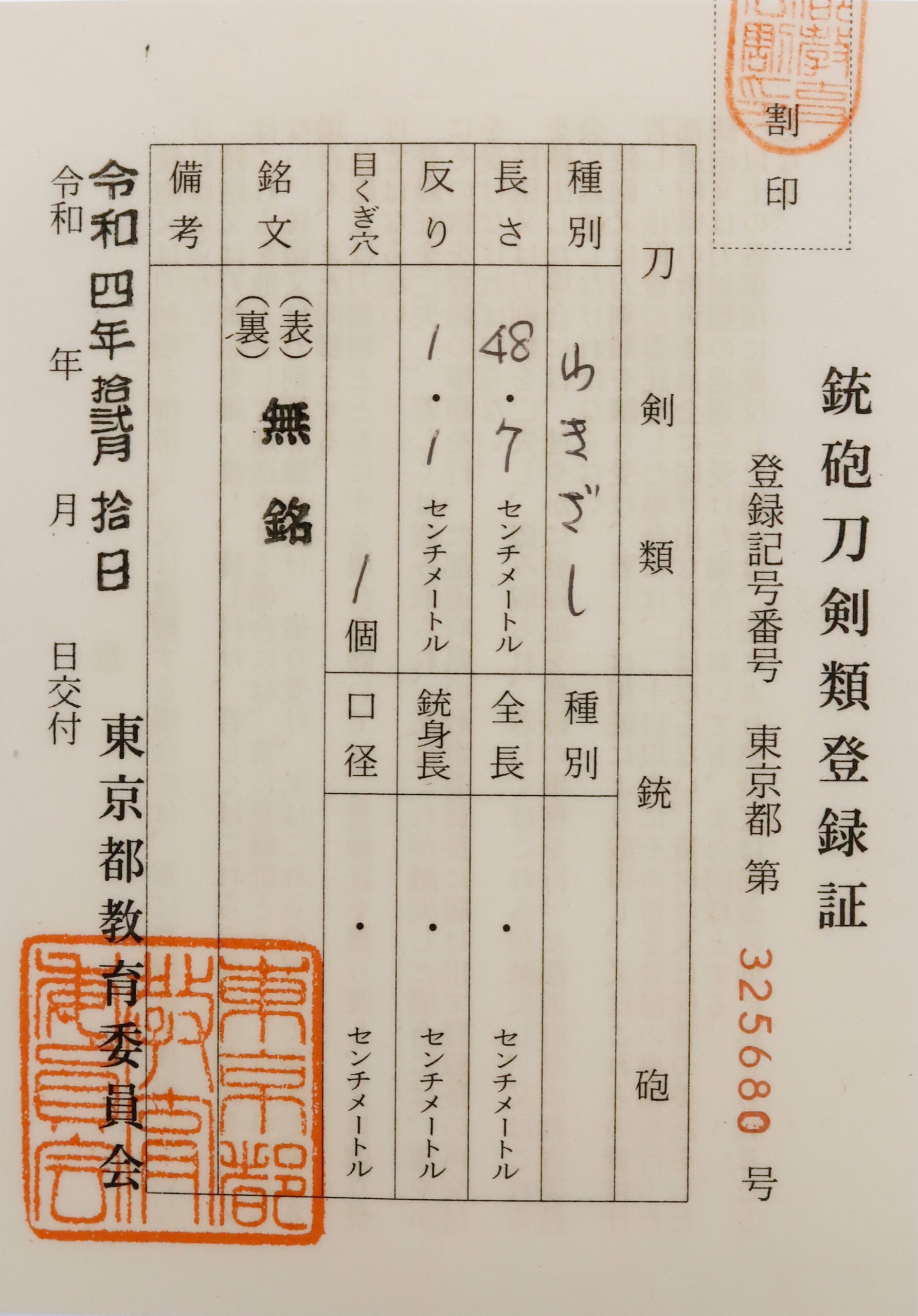

—————————————————————–
Special Christmas Gift Promotion
When you purchase an authentic Japanese sword, as a special Christmas Gift, we will also send you Sword of Japan, a great introductory book translated by Mr. Paul Martin.
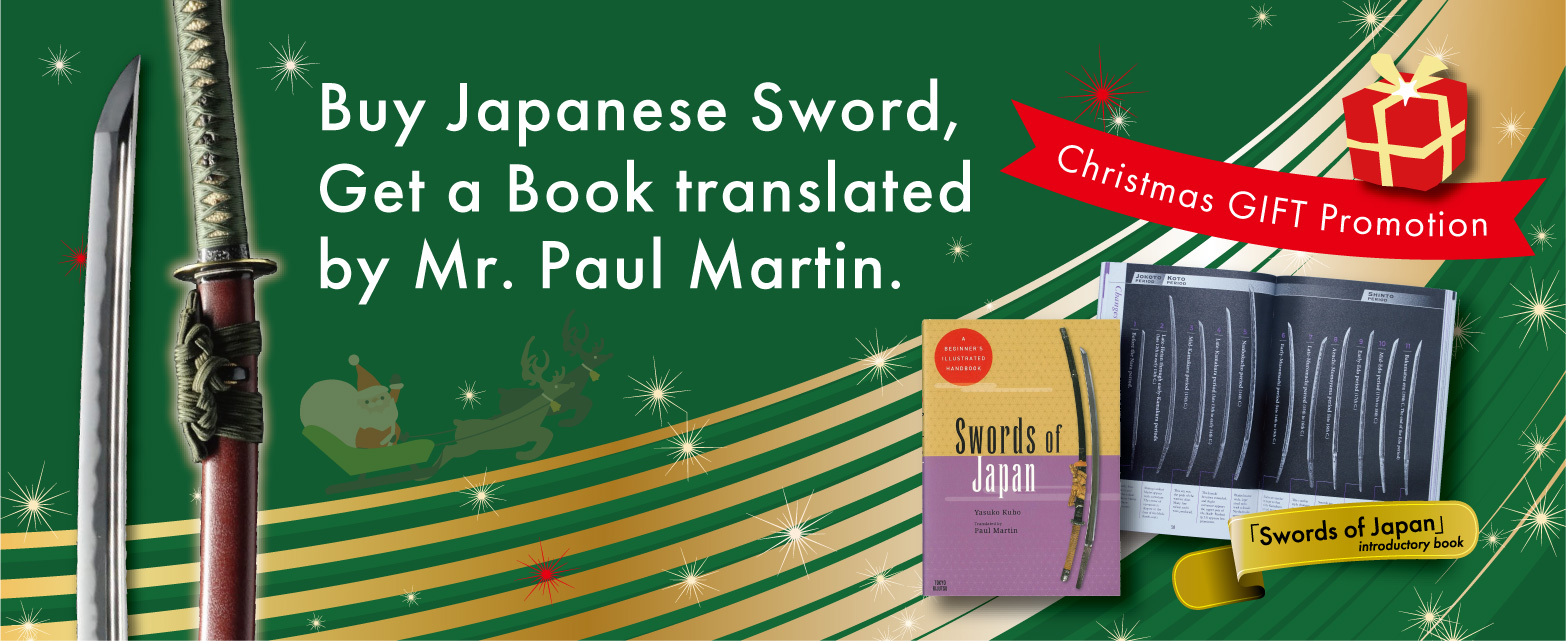
【About us】
Samurai Museum is located in Tokyo, Japan, exhibiting antique artifacts related to the Samurai history. Samurai Museum Shop is the place for those who are interested in Japanese culture and craftsmanship. We deal with antique Samurai swords/armor, traditional crafts made in Japan and so on.
【Japanese Sword& Export Process】
The Japanese swords we deal with are hand-forged edged swords made in Japan. It was made from the traditional carbon steel called TAMAHAGANE(玉鋼). Samurai Museum is familiar with the proper legal procedure for an antique/ authentic Japanese sword to be exported from Japan. We have sent more than 400 Japanese swords for the past three years (~2022) to amazing owners who appreciate its historical value.
Each Japanese sword is registered under the Agency for Cultural Affairs and the Board of Education in Japan. They issue a registration paper for each Japanese sword for its owner in Japan to legally possess it. The Japanese sword with its registration paper means it was traditionally hand-forged in Japan.
To legally export the sword from Japan to other countries, we will have to apply for its permit to the Agency for Cultural Affairs(Bunkacho) and return the original registration paper to the Board of Education. It normally takes around 2-4 weeks to receive this permit after submitting required documents. And we would like you to expect at least 1-1.5 months for your order to arrive at your given address after you ordered. For more detailed info, please click here.
It is allowed for residents in Japan to own authentic Japanese swords without a special license as long as they come with registration papers. Please feel free to contact us if you are a resident of Japan, whether temporarily or permanently. We will also assist you when you leave Japan and need to obtain the export permit.
【Payment Method】
We accept payment through Stripe (Credit card), PayPal, Apple Pay or ChromePay, all of which are secure payment methods. Also, you don’t need to make an account on Stripe for the checkout. If you prefer other payment method, please contact us. After confirming your payment, we will apply for an export permit. You may either pay in JPY, USD, AUD, CAD,EUR or GBP. The price is set in Japanese Yen. Prices in other currencies are automatically calculated based on the latest exchange rate.

* If the amount is above 1 million JPY, Stripe or wire transfer will be the only options for payment.
【Shipping】
We have shipped authentic Japanese swords to the USA, UK, Canada, Mexico, Germany, Switzerland, France, Hong Kong and Australia. If you don’t live in these countries and like to order, please contact us first before making a purchase. We offer Free International Shipping as long as we can send antique Japanese swords by either EMS or FedEx(Canada).
We normally ship by EMS(Express Mail Service) provided by Japan Post. When we receive an order from the Canada we will use FedEx instead as EMS temporarily stops shipping from Japan to those countries due to COVID-19.
We will send you a tracking number for your order as soon as we hand it to the post office/FedEx. We will put 100 % insurance on the shipping document without any extra charge. Based on the total amount, there might be a duty tax or other fee for you to pay, depending on the countries. We use package cushioning to protect the item and put it in a PVC pipe, which is one of the most secure packages because of its durability.
It will normally takes 5-14 days for the item to arrive at your given address after we dispatch it. Time of delivery is estimated as accurately as possible by the carrier but does not take into account any delays beyond our control such as by inclement weather, post office holiday seasons.
* If you live in Australia and like to purchase an authentic Japanese sword, please click here to know the detail.
*Please keep in mind that due to the spread of COVID-19, there might be delays in shipping. If you like to know the detail about shipping, please feel free to ask us.

【How to make sure the condition】
Please keep in mind that what you are going to purchase is an antique item. We uploaded high resolution photos for you to check its condition thoroughly. If you like to see more photos with different angles, please feel free to contact us. We will be happy to send them to you so that you can make informed decision. It is essential for us to know that you are happy with your choice of a sword. and we are prepared to use the best of our ability to serve you.
【How To Contact Us】
Please contact us through email, Facebook Messenger or Live Chat if you have any questions. You can find each icon on the right side of the website. Please click one of them to reach us. We will reply to you within 1-2 business days.
【The Art of Nihonto(Japanese Sword)】
Samurai’s history is a profound, eloquent legacy of ancient Japanese warriors in which millions of people worldwide are being fascinated. If you like to find out the art of Nihonto, please click here.
【A Guide to Japanese Sword Maintenance】
After acquiring an genuine Japanese sword, it is also important to know how to take good care of it. Here is the special video for you. Mr. Paul Martin, Japanese sword expert, shows you how to give proper maintenance to your sword. By mastering how to clean the Japanese sword, its aesthetic beauty will last forever.
When you purchase a Japanese sword from us, you can get a Free Japanese sword maintenance kit. It comes with four tools(Choji Oil, Uchiko Whetstone Powder, Peg remover, Oil Applicator). By watching the video instruction above , you can enjoy learning how to maintain your Japanese sword while appreciating it. If you have any difficulty assembling the sword or cleaning the blade, you can feel free to contact us.


MORE ANTIQUE JAPANESE SWORD FOR SALE
LEARN JAPANESE SWORD TERMINOLOGY
Thank you for reading all the information on the page. If you have any difficulty choosing the right Japanese sword for you, we will be more than happy to help you find the one that speaks to you the most. Please feel free to contact us.
